Global Marketing Report for Wesfarmers' Coles in Germany
VerifiedAdded on 2023/06/07
|22
|5479
|248
AI Summary
This report provides an overview of global marketing strategies for Wesfarmers' Coles in Germany. It includes an analysis of the five stages of overseas market selection process, alternative market entry strategies, target market selection, positioning, and marketing mix options. The report also includes a summary of the external environmental analysis of Germany and organisational analysis of Coles. The recommended strategies for Wesfarmers' Coles in Germany include franchising, direct exporting, and joint venture. The primary target customers are urban population of Germany, and the positioning statement of Coles is 'serving the people better'.
Contribute Materials
Your contribution can guide someone’s learning journey. Share your
documents today.
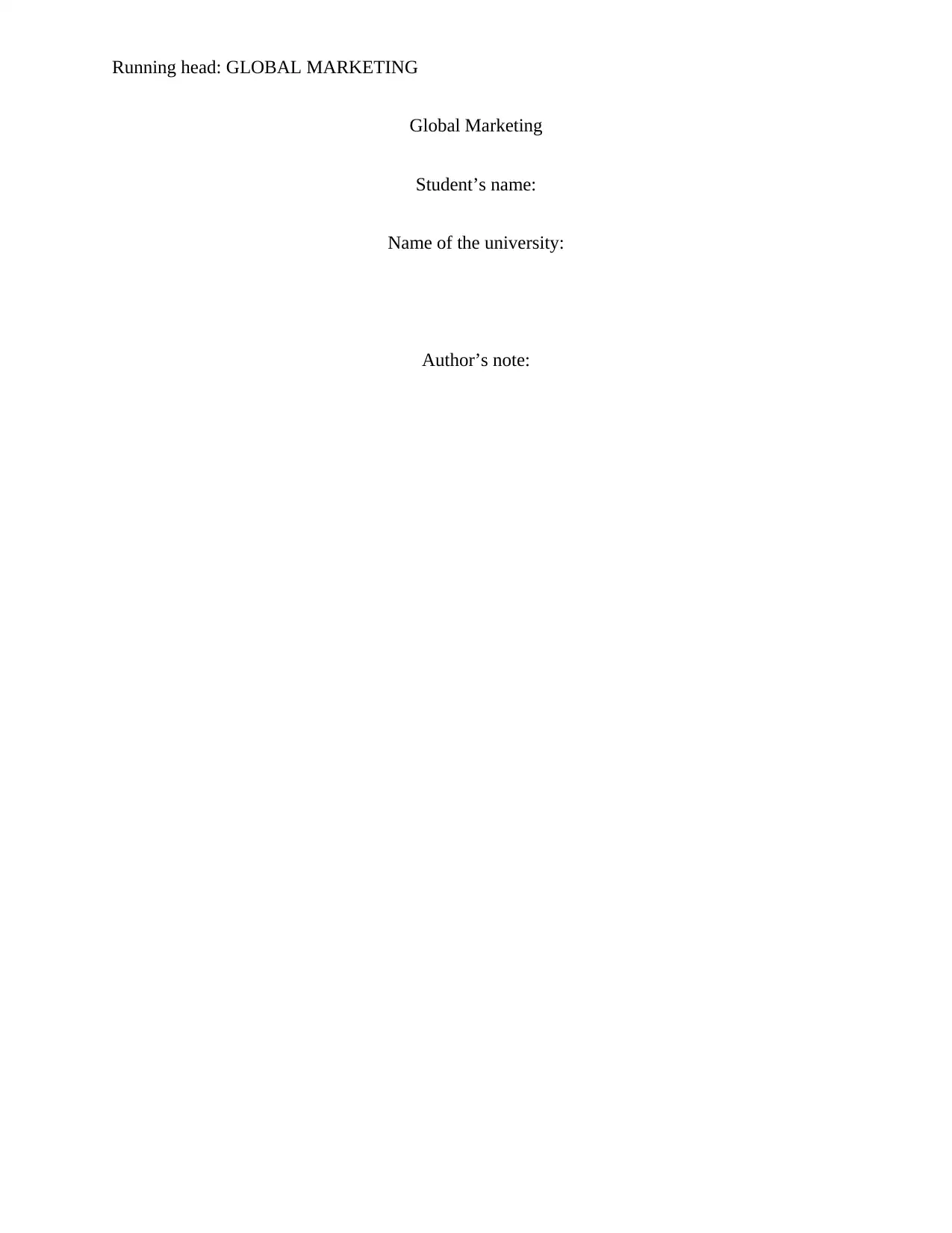
Running head: GLOBAL MARKETING
Global Marketing
Student’s name:
Name of the university:
Author’s note:
Global Marketing
Student’s name:
Name of the university:
Author’s note:
Secure Best Marks with AI Grader
Need help grading? Try our AI Grader for instant feedback on your assignments.
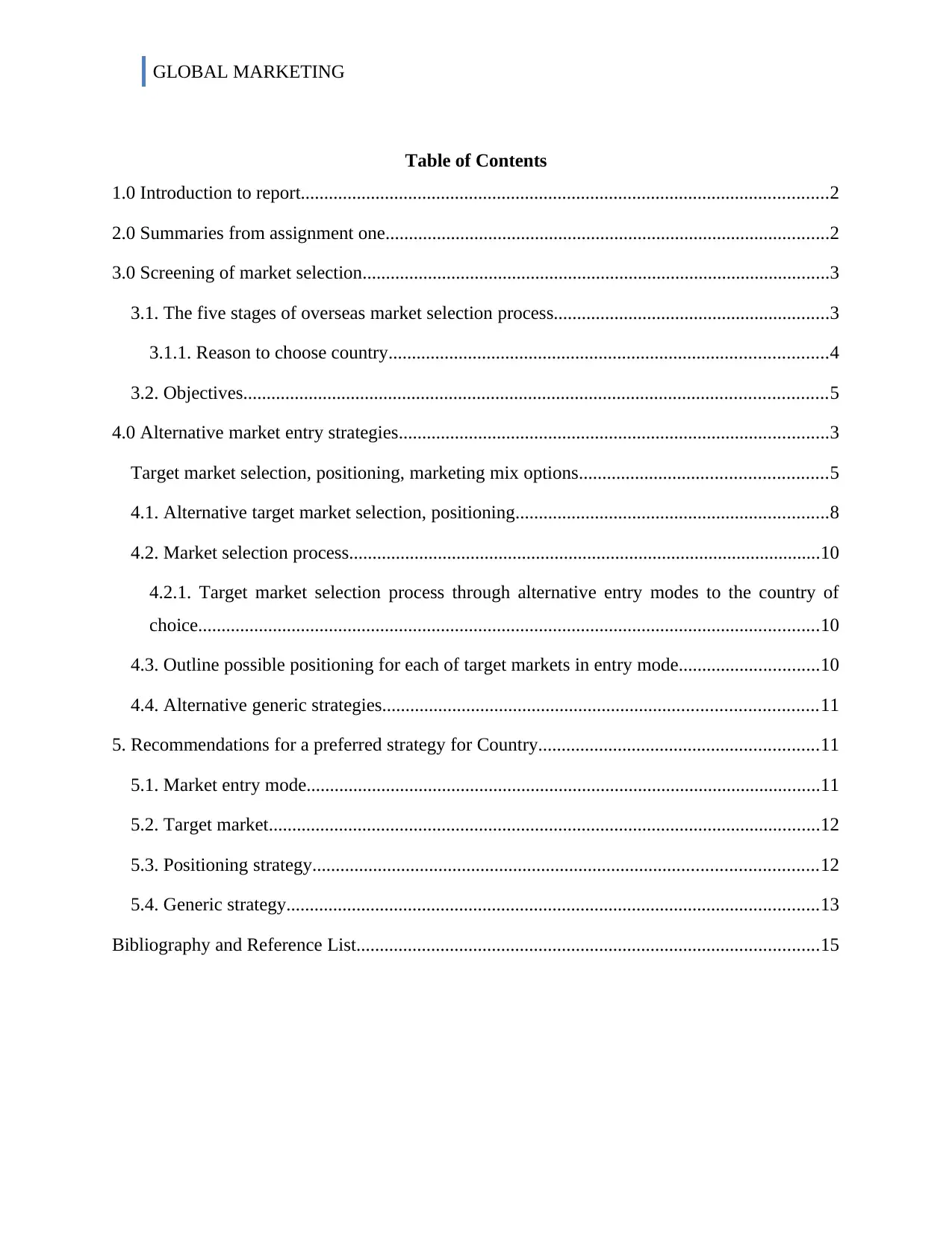
GLOBAL MARKETING
Table of Contents
1.0 Introduction to report.................................................................................................................2
2.0 Summaries from assignment one...............................................................................................2
3.0 Screening of market selection....................................................................................................3
3.1. The five stages of overseas market selection process...........................................................3
3.1.1. Reason to choose country..............................................................................................4
3.2. Objectives.............................................................................................................................5
4.0 Alternative market entry strategies............................................................................................3
Target market selection, positioning, marketing mix options.....................................................5
4.1. Alternative target market selection, positioning...................................................................8
4.2. Market selection process.....................................................................................................10
4.2.1. Target market selection process through alternative entry modes to the country of
choice.....................................................................................................................................10
4.3. Outline possible positioning for each of target markets in entry mode..............................10
4.4. Alternative generic strategies.............................................................................................11
5. Recommendations for a preferred strategy for Country............................................................11
5.1. Market entry mode..............................................................................................................11
5.2. Target market......................................................................................................................12
5.3. Positioning strategy............................................................................................................12
5.4. Generic strategy..................................................................................................................13
Bibliography and Reference List...................................................................................................15
Table of Contents
1.0 Introduction to report.................................................................................................................2
2.0 Summaries from assignment one...............................................................................................2
3.0 Screening of market selection....................................................................................................3
3.1. The five stages of overseas market selection process...........................................................3
3.1.1. Reason to choose country..............................................................................................4
3.2. Objectives.............................................................................................................................5
4.0 Alternative market entry strategies............................................................................................3
Target market selection, positioning, marketing mix options.....................................................5
4.1. Alternative target market selection, positioning...................................................................8
4.2. Market selection process.....................................................................................................10
4.2.1. Target market selection process through alternative entry modes to the country of
choice.....................................................................................................................................10
4.3. Outline possible positioning for each of target markets in entry mode..............................10
4.4. Alternative generic strategies.............................................................................................11
5. Recommendations for a preferred strategy for Country............................................................11
5.1. Market entry mode..............................................................................................................11
5.2. Target market......................................................................................................................12
5.3. Positioning strategy............................................................................................................12
5.4. Generic strategy..................................................................................................................13
Bibliography and Reference List...................................................................................................15
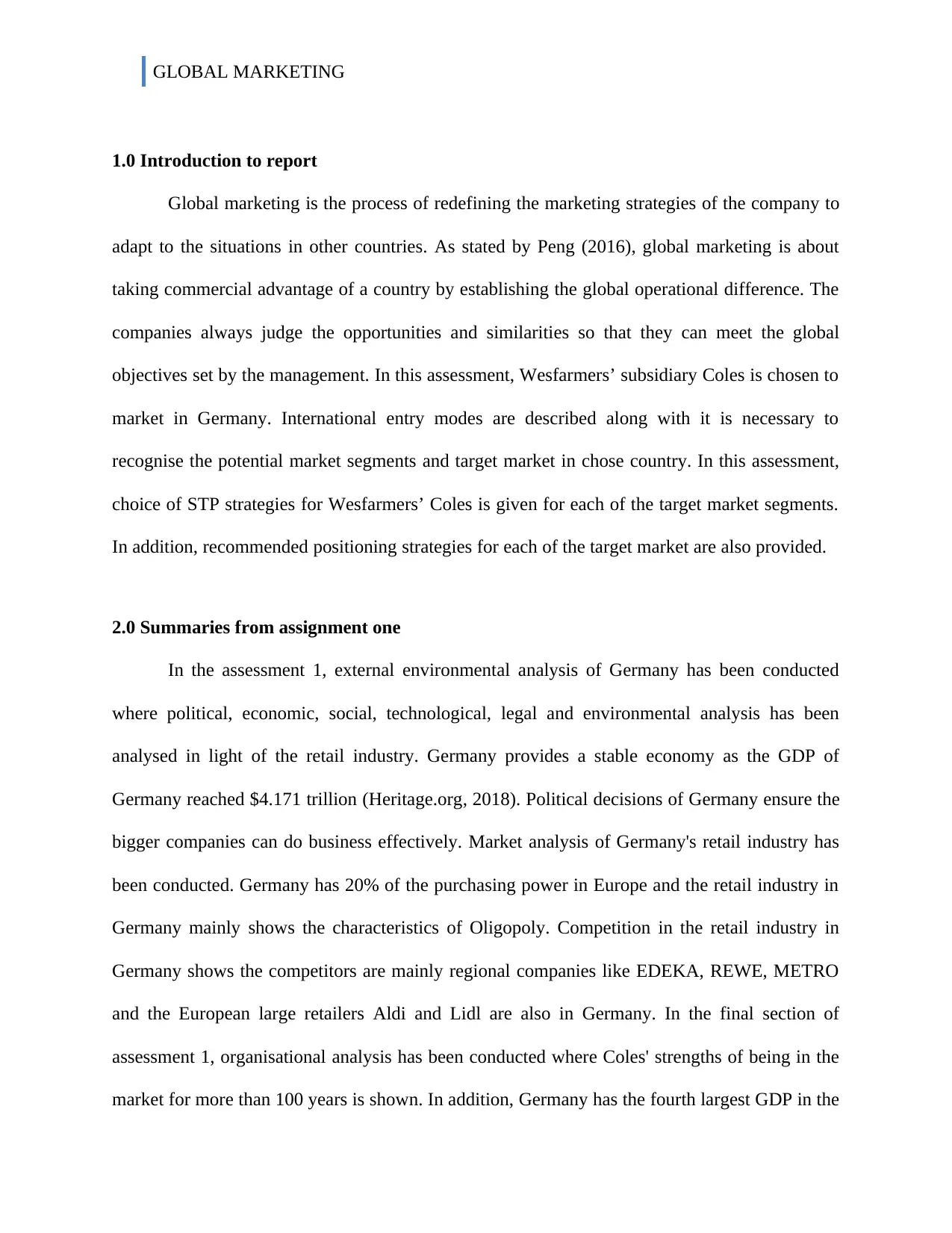
GLOBAL MARKETING
1.0 Introduction to report
Global marketing is the process of redefining the marketing strategies of the company to
adapt to the situations in other countries. As stated by Peng (2016), global marketing is about
taking commercial advantage of a country by establishing the global operational difference. The
companies always judge the opportunities and similarities so that they can meet the global
objectives set by the management. In this assessment, Wesfarmers’ subsidiary Coles is chosen to
market in Germany. International entry modes are described along with it is necessary to
recognise the potential market segments and target market in chose country. In this assessment,
choice of STP strategies for Wesfarmers’ Coles is given for each of the target market segments.
In addition, recommended positioning strategies for each of the target market are also provided.
2.0 Summaries from assignment one
In the assessment 1, external environmental analysis of Germany has been conducted
where political, economic, social, technological, legal and environmental analysis has been
analysed in light of the retail industry. Germany provides a stable economy as the GDP of
Germany reached $4.171 trillion (Heritage.org, 2018). Political decisions of Germany ensure the
bigger companies can do business effectively. Market analysis of Germany's retail industry has
been conducted. Germany has 20% of the purchasing power in Europe and the retail industry in
Germany mainly shows the characteristics of Oligopoly. Competition in the retail industry in
Germany shows the competitors are mainly regional companies like EDEKA, REWE, METRO
and the European large retailers Aldi and Lidl are also in Germany. In the final section of
assessment 1, organisational analysis has been conducted where Coles' strengths of being in the
market for more than 100 years is shown. In addition, Germany has the fourth largest GDP in the
1.0 Introduction to report
Global marketing is the process of redefining the marketing strategies of the company to
adapt to the situations in other countries. As stated by Peng (2016), global marketing is about
taking commercial advantage of a country by establishing the global operational difference. The
companies always judge the opportunities and similarities so that they can meet the global
objectives set by the management. In this assessment, Wesfarmers’ subsidiary Coles is chosen to
market in Germany. International entry modes are described along with it is necessary to
recognise the potential market segments and target market in chose country. In this assessment,
choice of STP strategies for Wesfarmers’ Coles is given for each of the target market segments.
In addition, recommended positioning strategies for each of the target market are also provided.
2.0 Summaries from assignment one
In the assessment 1, external environmental analysis of Germany has been conducted
where political, economic, social, technological, legal and environmental analysis has been
analysed in light of the retail industry. Germany provides a stable economy as the GDP of
Germany reached $4.171 trillion (Heritage.org, 2018). Political decisions of Germany ensure the
bigger companies can do business effectively. Market analysis of Germany's retail industry has
been conducted. Germany has 20% of the purchasing power in Europe and the retail industry in
Germany mainly shows the characteristics of Oligopoly. Competition in the retail industry in
Germany shows the competitors are mainly regional companies like EDEKA, REWE, METRO
and the European large retailers Aldi and Lidl are also in Germany. In the final section of
assessment 1, organisational analysis has been conducted where Coles' strengths of being in the
market for more than 100 years is shown. In addition, Germany has the fourth largest GDP in the
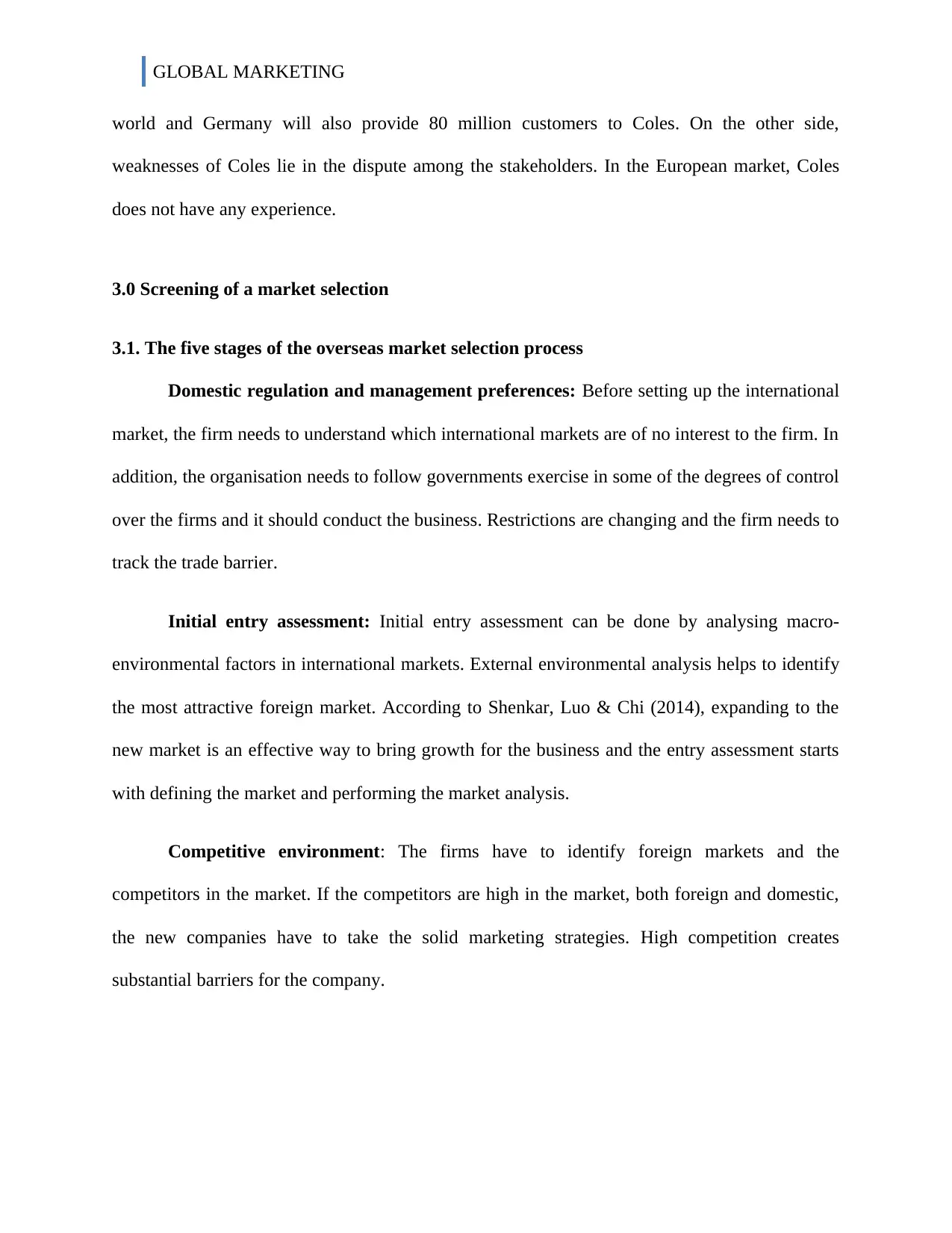
GLOBAL MARKETING
world and Germany will also provide 80 million customers to Coles. On the other side,
weaknesses of Coles lie in the dispute among the stakeholders. In the European market, Coles
does not have any experience.
3.0 Screening of a market selection
3.1. The five stages of the overseas market selection process
Domestic regulation and management preferences: Before setting up the international
market, the firm needs to understand which international markets are of no interest to the firm. In
addition, the organisation needs to follow governments exercise in some of the degrees of control
over the firms and it should conduct the business. Restrictions are changing and the firm needs to
track the trade barrier.
Initial entry assessment: Initial entry assessment can be done by analysing macro-
environmental factors in international markets. External environmental analysis helps to identify
the most attractive foreign market. According to Shenkar, Luo & Chi (2014), expanding to the
new market is an effective way to bring growth for the business and the entry assessment starts
with defining the market and performing the market analysis.
Competitive environment: The firms have to identify foreign markets and the
competitors in the market. If the competitors are high in the market, both foreign and domestic,
the new companies have to take the solid marketing strategies. High competition creates
substantial barriers for the company.
world and Germany will also provide 80 million customers to Coles. On the other side,
weaknesses of Coles lie in the dispute among the stakeholders. In the European market, Coles
does not have any experience.
3.0 Screening of a market selection
3.1. The five stages of the overseas market selection process
Domestic regulation and management preferences: Before setting up the international
market, the firm needs to understand which international markets are of no interest to the firm. In
addition, the organisation needs to follow governments exercise in some of the degrees of control
over the firms and it should conduct the business. Restrictions are changing and the firm needs to
track the trade barrier.
Initial entry assessment: Initial entry assessment can be done by analysing macro-
environmental factors in international markets. External environmental analysis helps to identify
the most attractive foreign market. According to Shenkar, Luo & Chi (2014), expanding to the
new market is an effective way to bring growth for the business and the entry assessment starts
with defining the market and performing the market analysis.
Competitive environment: The firms have to identify foreign markets and the
competitors in the market. If the competitors are high in the market, both foreign and domestic,
the new companies have to take the solid marketing strategies. High competition creates
substantial barriers for the company.
Secure Best Marks with AI Grader
Need help grading? Try our AI Grader for instant feedback on your assignments.
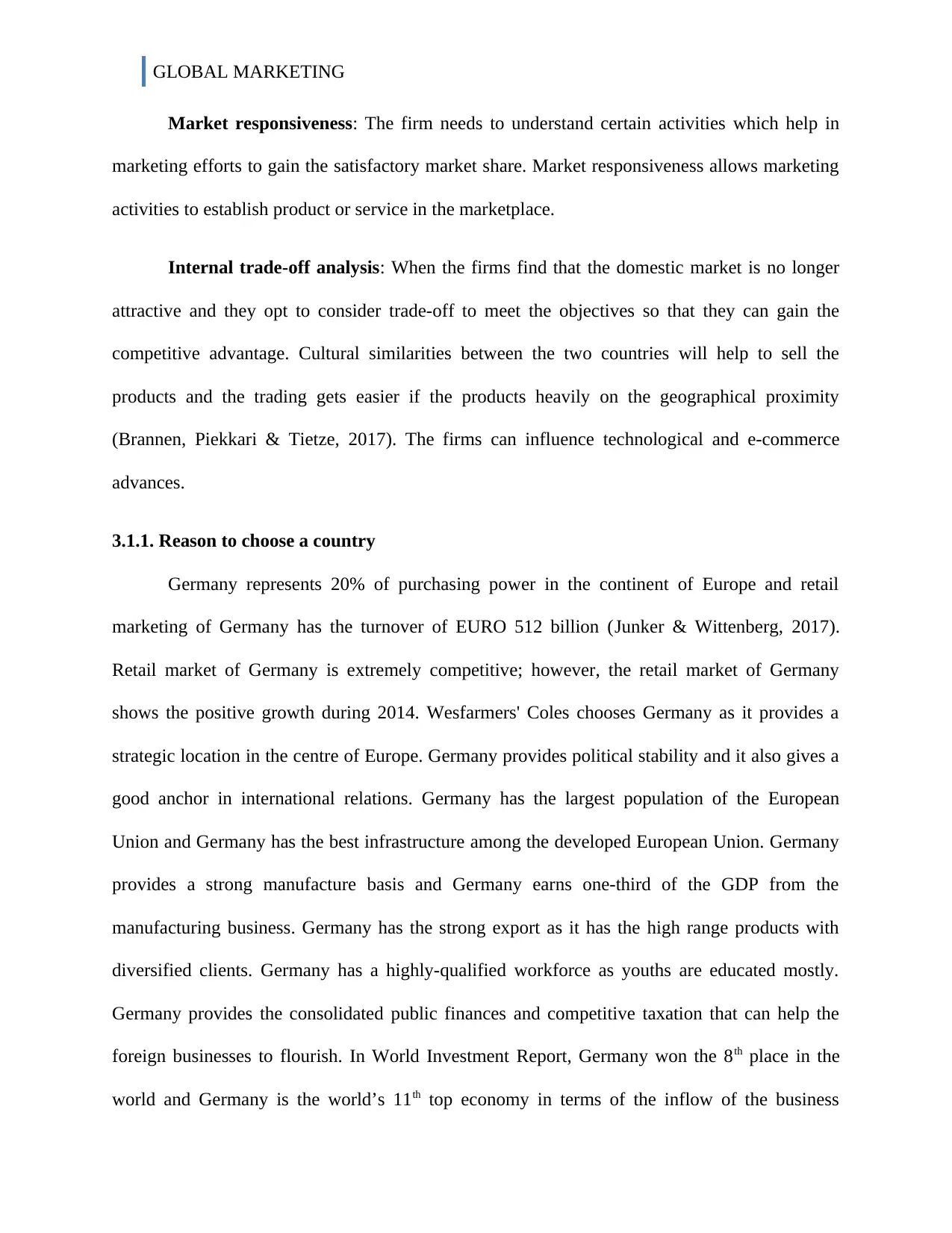
GLOBAL MARKETING
Market responsiveness: The firm needs to understand certain activities which help in
marketing efforts to gain the satisfactory market share. Market responsiveness allows marketing
activities to establish product or service in the marketplace.
Internal trade-off analysis: When the firms find that the domestic market is no longer
attractive and they opt to consider trade-off to meet the objectives so that they can gain the
competitive advantage. Cultural similarities between the two countries will help to sell the
products and the trading gets easier if the products heavily on the geographical proximity
(Brannen, Piekkari & Tietze, 2017). The firms can influence technological and e-commerce
advances.
3.1.1. Reason to choose a country
Germany represents 20% of purchasing power in the continent of Europe and retail
marketing of Germany has the turnover of EURO 512 billion (Junker & Wittenberg, 2017).
Retail market of Germany is extremely competitive; however, the retail market of Germany
shows the positive growth during 2014. Wesfarmers' Coles chooses Germany as it provides a
strategic location in the centre of Europe. Germany provides political stability and it also gives a
good anchor in international relations. Germany has the largest population of the European
Union and Germany has the best infrastructure among the developed European Union. Germany
provides a strong manufacture basis and Germany earns one-third of the GDP from the
manufacturing business. Germany has the strong export as it has the high range products with
diversified clients. Germany has a highly-qualified workforce as youths are educated mostly.
Germany provides the consolidated public finances and competitive taxation that can help the
foreign businesses to flourish. In World Investment Report, Germany won the 8th place in the
world and Germany is the world’s 11th top economy in terms of the inflow of the business
Market responsiveness: The firm needs to understand certain activities which help in
marketing efforts to gain the satisfactory market share. Market responsiveness allows marketing
activities to establish product or service in the marketplace.
Internal trade-off analysis: When the firms find that the domestic market is no longer
attractive and they opt to consider trade-off to meet the objectives so that they can gain the
competitive advantage. Cultural similarities between the two countries will help to sell the
products and the trading gets easier if the products heavily on the geographical proximity
(Brannen, Piekkari & Tietze, 2017). The firms can influence technological and e-commerce
advances.
3.1.1. Reason to choose a country
Germany represents 20% of purchasing power in the continent of Europe and retail
marketing of Germany has the turnover of EURO 512 billion (Junker & Wittenberg, 2017).
Retail market of Germany is extremely competitive; however, the retail market of Germany
shows the positive growth during 2014. Wesfarmers' Coles chooses Germany as it provides a
strategic location in the centre of Europe. Germany provides political stability and it also gives a
good anchor in international relations. Germany has the largest population of the European
Union and Germany has the best infrastructure among the developed European Union. Germany
provides a strong manufacture basis and Germany earns one-third of the GDP from the
manufacturing business. Germany has the strong export as it has the high range products with
diversified clients. Germany has a highly-qualified workforce as youths are educated mostly.
Germany provides the consolidated public finances and competitive taxation that can help the
foreign businesses to flourish. In World Investment Report, Germany won the 8th place in the
world and Germany is the world’s 11th top economy in terms of the inflow of the business
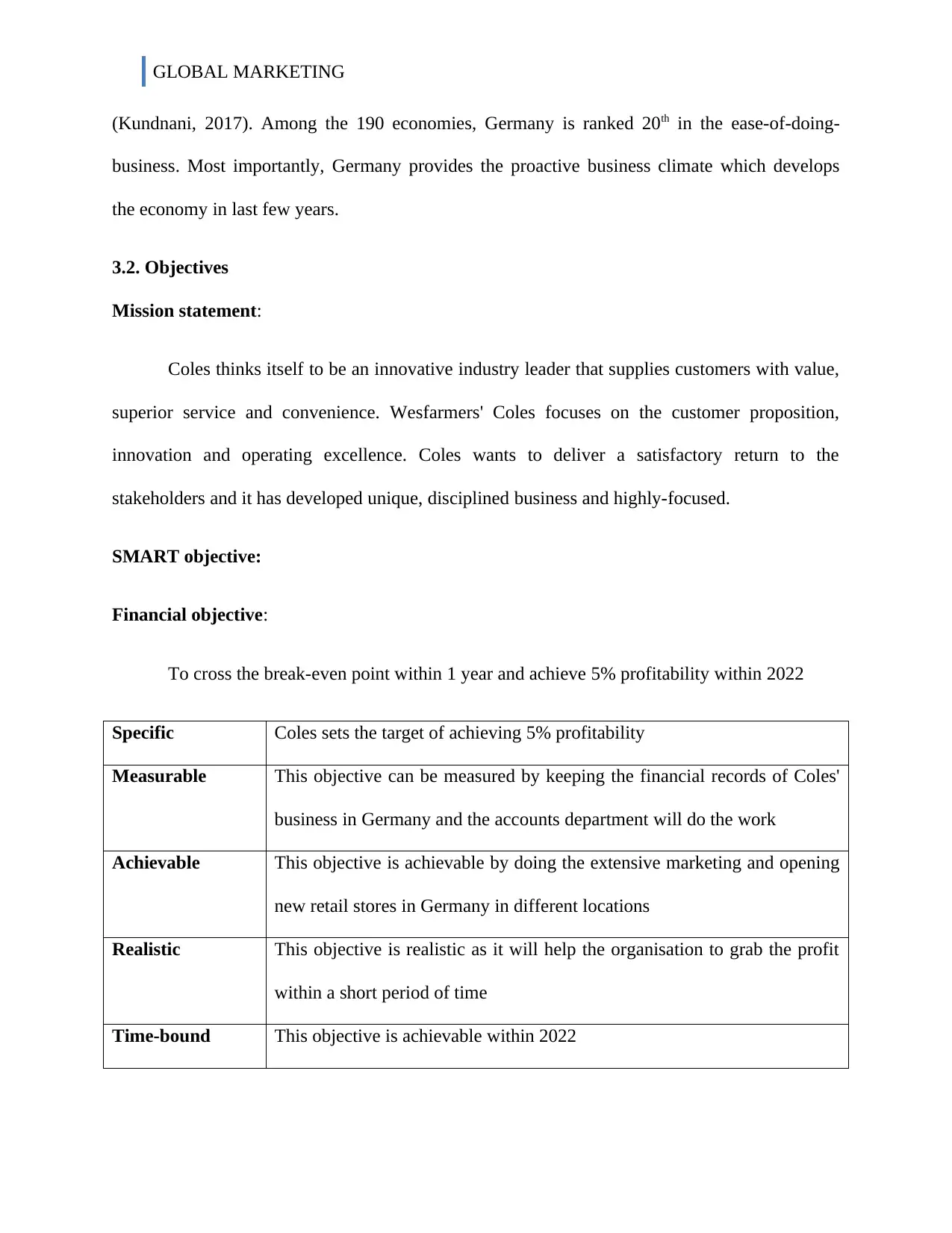
GLOBAL MARKETING
(Kundnani, 2017). Among the 190 economies, Germany is ranked 20th in the ease-of-doing-
business. Most importantly, Germany provides the proactive business climate which develops
the economy in last few years.
3.2. Objectives
Mission statement:
Coles thinks itself to be an innovative industry leader that supplies customers with value,
superior service and convenience. Wesfarmers' Coles focuses on the customer proposition,
innovation and operating excellence. Coles wants to deliver a satisfactory return to the
stakeholders and it has developed unique, disciplined business and highly-focused.
SMART objective:
Financial objective:
To cross the break-even point within 1 year and achieve 5% profitability within 2022
Specific Coles sets the target of achieving 5% profitability
Measurable This objective can be measured by keeping the financial records of Coles'
business in Germany and the accounts department will do the work
Achievable This objective is achievable by doing the extensive marketing and opening
new retail stores in Germany in different locations
Realistic This objective is realistic as it will help the organisation to grab the profit
within a short period of time
Time-bound This objective is achievable within 2022
(Kundnani, 2017). Among the 190 economies, Germany is ranked 20th in the ease-of-doing-
business. Most importantly, Germany provides the proactive business climate which develops
the economy in last few years.
3.2. Objectives
Mission statement:
Coles thinks itself to be an innovative industry leader that supplies customers with value,
superior service and convenience. Wesfarmers' Coles focuses on the customer proposition,
innovation and operating excellence. Coles wants to deliver a satisfactory return to the
stakeholders and it has developed unique, disciplined business and highly-focused.
SMART objective:
Financial objective:
To cross the break-even point within 1 year and achieve 5% profitability within 2022
Specific Coles sets the target of achieving 5% profitability
Measurable This objective can be measured by keeping the financial records of Coles'
business in Germany and the accounts department will do the work
Achievable This objective is achievable by doing the extensive marketing and opening
new retail stores in Germany in different locations
Realistic This objective is realistic as it will help the organisation to grab the profit
within a short period of time
Time-bound This objective is achievable within 2022

GLOBAL MARKETING
Market share objective:
To gain 3% of the market share in Germany by the end of 2022
Specific Gaining 3% of the market share
Measurable Coles can measure the market share by doing an annual survey in the
industry or by checking the annual report published by Government each
year
Achievable Coles can achieve the market share by increasing the numbers of retail
stores in Germany and through strengthening the customer relationship,
innovation and doing the smart hiring process
Realistic This objective is realistic as it will bring more revenue
Time-bound This objective is achievable within 2022
Market share objective:
To gain 3% of the market share in Germany by the end of 2022
Specific Gaining 3% of the market share
Measurable Coles can measure the market share by doing an annual survey in the
industry or by checking the annual report published by Government each
year
Achievable Coles can achieve the market share by increasing the numbers of retail
stores in Germany and through strengthening the customer relationship,
innovation and doing the smart hiring process
Realistic This objective is realistic as it will bring more revenue
Time-bound This objective is achievable within 2022
Paraphrase This Document
Need a fresh take? Get an instant paraphrase of this document with our AI Paraphraser
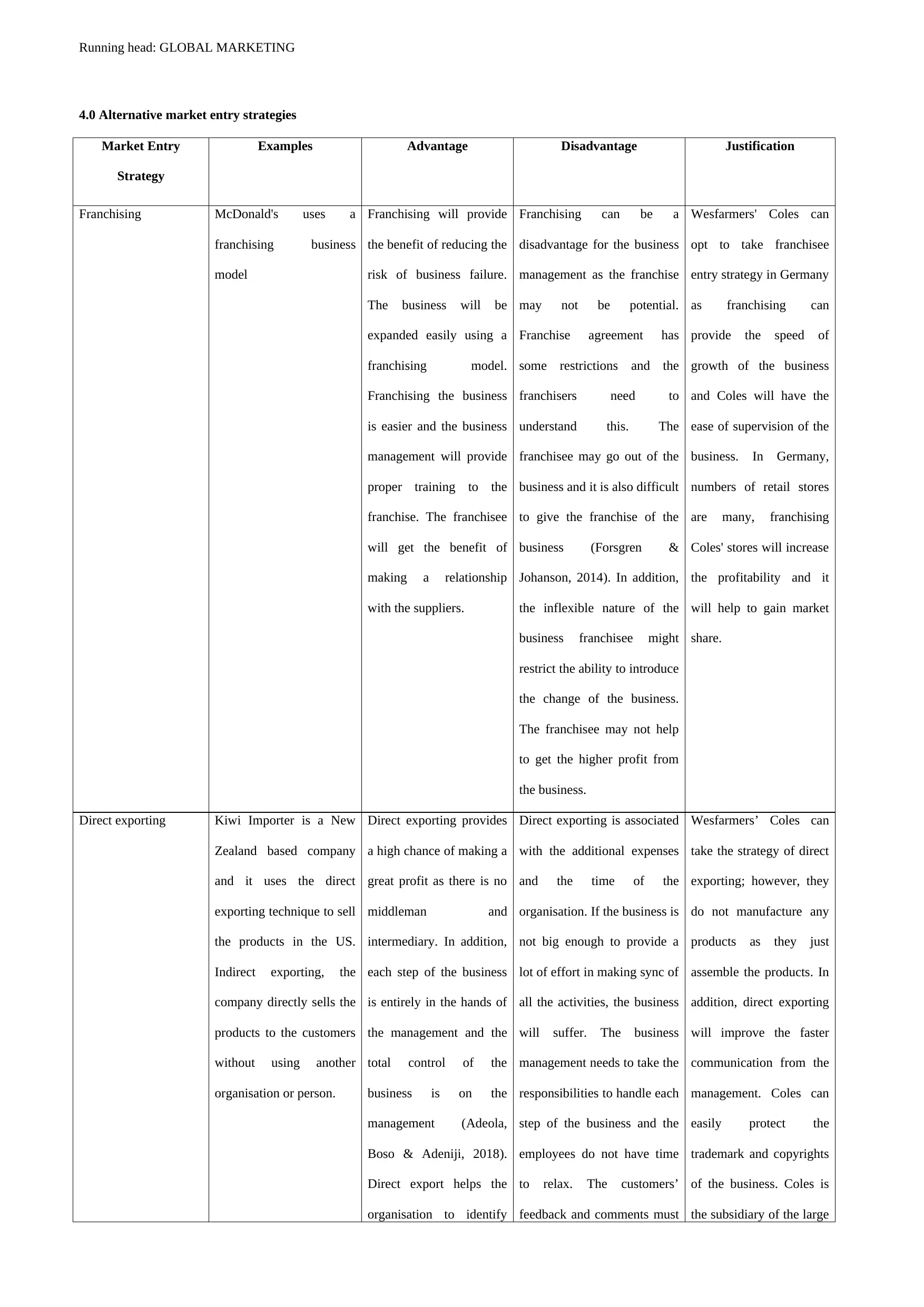
Running head: GLOBAL MARKETING
4.0 Alternative market entry strategies
Market Entry
Strategy
Examples Advantage Disadvantage Justification
Franchising McDonald's uses a
franchising business
model
Franchising will provide
the benefit of reducing the
risk of business failure.
The business will be
expanded easily using a
franchising model.
Franchising the business
is easier and the business
management will provide
proper training to the
franchise. The franchisee
will get the benefit of
making a relationship
with the suppliers.
Franchising can be a
disadvantage for the business
management as the franchise
may not be potential.
Franchise agreement has
some restrictions and the
franchisers need to
understand this. The
franchisee may go out of the
business and it is also difficult
to give the franchise of the
business (Forsgren &
Johanson, 2014). In addition,
the inflexible nature of the
business franchisee might
restrict the ability to introduce
the change of the business.
The franchisee may not help
to get the higher profit from
the business.
Wesfarmers' Coles can
opt to take franchisee
entry strategy in Germany
as franchising can
provide the speed of
growth of the business
and Coles will have the
ease of supervision of the
business. In Germany,
numbers of retail stores
are many, franchising
Coles' stores will increase
the profitability and it
will help to gain market
share.
Direct exporting Kiwi Importer is a New
Zealand based company
and it uses the direct
exporting technique to sell
the products in the US.
Indirect exporting, the
company directly sells the
products to the customers
without using another
organisation or person.
Direct exporting provides
a high chance of making a
great profit as there is no
middleman and
intermediary. In addition,
each step of the business
is entirely in the hands of
the management and the
total control of the
business is on the
management (Adeola,
Boso & Adeniji, 2018).
Direct export helps the
organisation to identify
Direct exporting is associated
with the additional expenses
and the time of the
organisation. If the business is
not big enough to provide a
lot of effort in making sync of
all the activities, the business
will suffer. The business
management needs to take the
responsibilities to handle each
step of the business and the
employees do not have time
to relax. The customers’
feedback and comments must
Wesfarmers’ Coles can
take the strategy of direct
exporting; however, they
do not manufacture any
products as they just
assemble the products. In
addition, direct exporting
will improve the faster
communication from the
management. Coles can
easily protect the
trademark and copyrights
of the business. Coles is
the subsidiary of the large
4.0 Alternative market entry strategies
Market Entry
Strategy
Examples Advantage Disadvantage Justification
Franchising McDonald's uses a
franchising business
model
Franchising will provide
the benefit of reducing the
risk of business failure.
The business will be
expanded easily using a
franchising model.
Franchising the business
is easier and the business
management will provide
proper training to the
franchise. The franchisee
will get the benefit of
making a relationship
with the suppliers.
Franchising can be a
disadvantage for the business
management as the franchise
may not be potential.
Franchise agreement has
some restrictions and the
franchisers need to
understand this. The
franchisee may go out of the
business and it is also difficult
to give the franchise of the
business (Forsgren &
Johanson, 2014). In addition,
the inflexible nature of the
business franchisee might
restrict the ability to introduce
the change of the business.
The franchisee may not help
to get the higher profit from
the business.
Wesfarmers' Coles can
opt to take franchisee
entry strategy in Germany
as franchising can
provide the speed of
growth of the business
and Coles will have the
ease of supervision of the
business. In Germany,
numbers of retail stores
are many, franchising
Coles' stores will increase
the profitability and it
will help to gain market
share.
Direct exporting Kiwi Importer is a New
Zealand based company
and it uses the direct
exporting technique to sell
the products in the US.
Indirect exporting, the
company directly sells the
products to the customers
without using another
organisation or person.
Direct exporting provides
a high chance of making a
great profit as there is no
middleman and
intermediary. In addition,
each step of the business
is entirely in the hands of
the management and the
total control of the
business is on the
management (Adeola,
Boso & Adeniji, 2018).
Direct export helps the
organisation to identify
Direct exporting is associated
with the additional expenses
and the time of the
organisation. If the business is
not big enough to provide a
lot of effort in making sync of
all the activities, the business
will suffer. The business
management needs to take the
responsibilities to handle each
step of the business and the
employees do not have time
to relax. The customers’
feedback and comments must
Wesfarmers’ Coles can
take the strategy of direct
exporting; however, they
do not manufacture any
products as they just
assemble the products. In
addition, direct exporting
will improve the faster
communication from the
management. Coles can
easily protect the
trademark and copyrights
of the business. Coles is
the subsidiary of the large

GLOBAL MARKETING
the potential buyers in the
different country along
with the buying
behaviour.
be handled carefully. organisation Wesfarmers,
therefore, it will not be
tough for the
management to employ
large numbers of
employees in doing the
business in Germany. It
will also help to extend
the market in Germany.
Joint venture The joint venture is a
popular market entry
strategy. Vodafone and
Telefonica agreed to share
their mobile network in
the UK.
The joint venture provides
access to a new market
and to the new
distribution networks. The
joint venture also
increases the capacity of
the organisation and it
shares the costs and risks
between two companies.
Moreover, joint venture
provides accesses to
greater resources like
technology, specialised
staffs and finance.
The joint venture will be risky
if the employees of the two
companies cannot work
together. Both the companies
need to go for a similar
objective (Hofer & Baba,
2018). If the partners have
different objectives, then the
firm will suffer. In addition,
partners of the joint venture
can bring different levels of
expertise in the business.
Coles can choose Joint
Venture to enter Germany
by selecting an existing
retail company. Coles can
choose existing regional
retail company as part of
the venture. It will
provide the benefit of
knowing the existing
customers and the
organisation can gain
existing market share at
the same time. Coles can
use the venture partner’s
customer database and
they can use join forces to
purchase, develop and
research.
the potential buyers in the
different country along
with the buying
behaviour.
be handled carefully. organisation Wesfarmers,
therefore, it will not be
tough for the
management to employ
large numbers of
employees in doing the
business in Germany. It
will also help to extend
the market in Germany.
Joint venture The joint venture is a
popular market entry
strategy. Vodafone and
Telefonica agreed to share
their mobile network in
the UK.
The joint venture provides
access to a new market
and to the new
distribution networks. The
joint venture also
increases the capacity of
the organisation and it
shares the costs and risks
between two companies.
Moreover, joint venture
provides accesses to
greater resources like
technology, specialised
staffs and finance.
The joint venture will be risky
if the employees of the two
companies cannot work
together. Both the companies
need to go for a similar
objective (Hofer & Baba,
2018). If the partners have
different objectives, then the
firm will suffer. In addition,
partners of the joint venture
can bring different levels of
expertise in the business.
Coles can choose Joint
Venture to enter Germany
by selecting an existing
retail company. Coles can
choose existing regional
retail company as part of
the venture. It will
provide the benefit of
knowing the existing
customers and the
organisation can gain
existing market share at
the same time. Coles can
use the venture partner’s
customer database and
they can use join forces to
purchase, develop and
research.

Running head: GLOBAL MARKETING
Target market selection, positioning, marketing mix options
Target market:
In Germany, primary target customers of Coles can be an urban population of
Germany. The retail stores of Coles will be opened mainly near the urban sections. Therefore,
urban people will be the main target who can afford to visit the retail stores of Coles.
The secondary target customers of Coles will be based on the demographic target
customers, mainly the middle and upper-income category people. The middle class and
upper-class people mainly visit Coles' supermarket. Upper and middle-class family people
visit supermarket for their daily needs. Single individuals or the members of the extended
families visit the supermarket as they have different needs in the supermarket.
Positioning:
Wesfarmers’ Coles follows the positioning statement of ‘serving the people better’
and it mainly focuses on the consumer proposition, operating excellence and innovation. In
Germany, the positioning statement of Coles can be associated with the increased range and
quality of the products functionalities. Varieties of products with lower price can attract
maximum numbers of customers in Germany.
Marketing Mix:
Product: Coles is a supermarket as Coles always focuses to deliver value along with
quality for the customers. Major offerings of Coles are baby products, dairy, fresh vegetables,
fruits, bakery, gift cards, liquor and meat. The products are mainly top-quality and it means
that the products are fresh. Coles provides special diets to the customers, Gluten-free and
kosher. Coles offers low-cost pantry fillers to the customers of diverse ranges. Therefore, the
product strategy will be creating a new product line.
Target market selection, positioning, marketing mix options
Target market:
In Germany, primary target customers of Coles can be an urban population of
Germany. The retail stores of Coles will be opened mainly near the urban sections. Therefore,
urban people will be the main target who can afford to visit the retail stores of Coles.
The secondary target customers of Coles will be based on the demographic target
customers, mainly the middle and upper-income category people. The middle class and
upper-class people mainly visit Coles' supermarket. Upper and middle-class family people
visit supermarket for their daily needs. Single individuals or the members of the extended
families visit the supermarket as they have different needs in the supermarket.
Positioning:
Wesfarmers’ Coles follows the positioning statement of ‘serving the people better’
and it mainly focuses on the consumer proposition, operating excellence and innovation. In
Germany, the positioning statement of Coles can be associated with the increased range and
quality of the products functionalities. Varieties of products with lower price can attract
maximum numbers of customers in Germany.
Marketing Mix:
Product: Coles is a supermarket as Coles always focuses to deliver value along with
quality for the customers. Major offerings of Coles are baby products, dairy, fresh vegetables,
fruits, bakery, gift cards, liquor and meat. The products are mainly top-quality and it means
that the products are fresh. Coles provides special diets to the customers, Gluten-free and
kosher. Coles offers low-cost pantry fillers to the customers of diverse ranges. Therefore, the
product strategy will be creating a new product line.
Secure Best Marks with AI Grader
Need help grading? Try our AI Grader for instant feedback on your assignments.
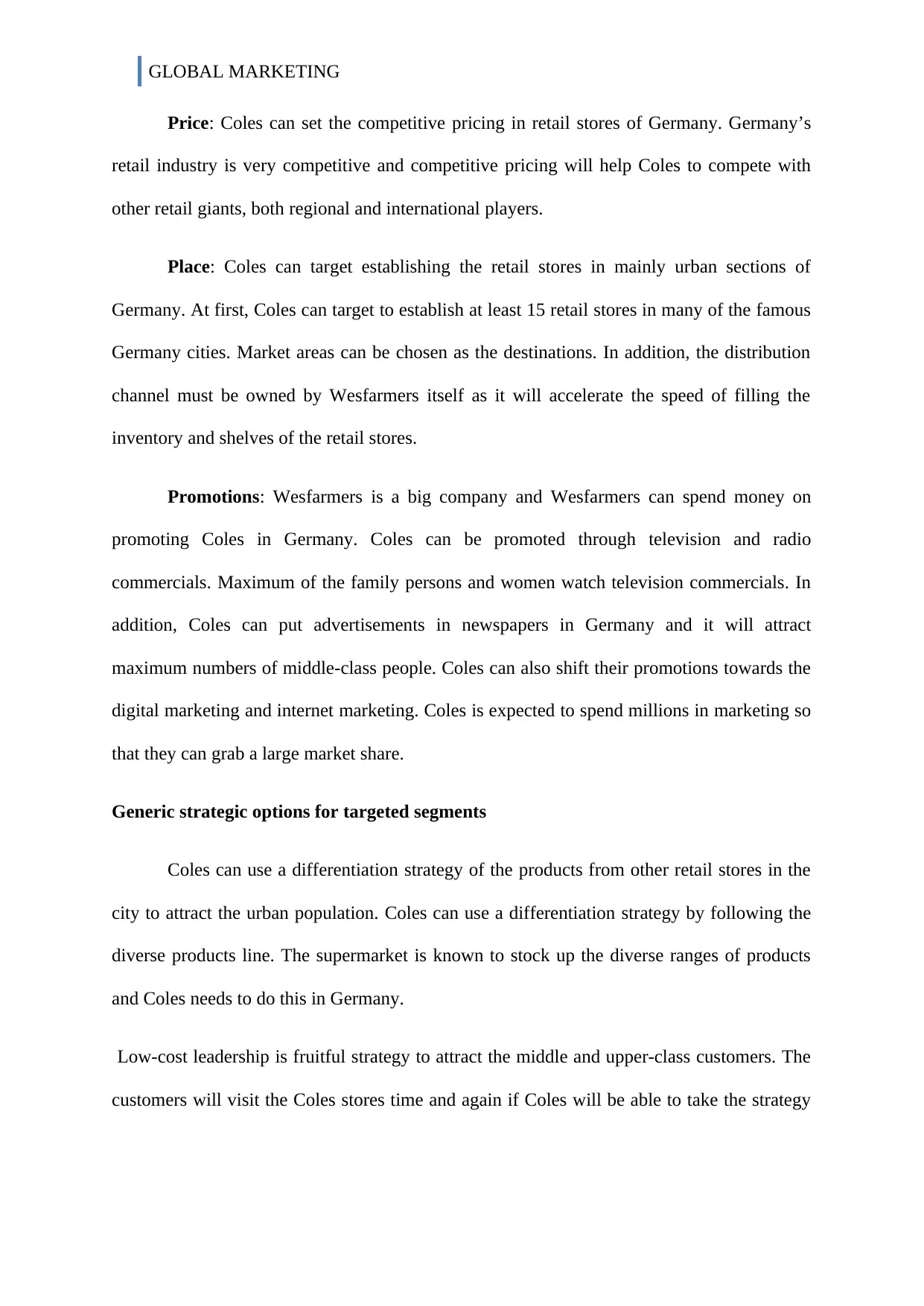
GLOBAL MARKETING
Price: Coles can set the competitive pricing in retail stores of Germany. Germany’s
retail industry is very competitive and competitive pricing will help Coles to compete with
other retail giants, both regional and international players.
Place: Coles can target establishing the retail stores in mainly urban sections of
Germany. At first, Coles can target to establish at least 15 retail stores in many of the famous
Germany cities. Market areas can be chosen as the destinations. In addition, the distribution
channel must be owned by Wesfarmers itself as it will accelerate the speed of filling the
inventory and shelves of the retail stores.
Promotions: Wesfarmers is a big company and Wesfarmers can spend money on
promoting Coles in Germany. Coles can be promoted through television and radio
commercials. Maximum of the family persons and women watch television commercials. In
addition, Coles can put advertisements in newspapers in Germany and it will attract
maximum numbers of middle-class people. Coles can also shift their promotions towards the
digital marketing and internet marketing. Coles is expected to spend millions in marketing so
that they can grab a large market share.
Generic strategic options for targeted segments
Coles can use a differentiation strategy of the products from other retail stores in the
city to attract the urban population. Coles can use a differentiation strategy by following the
diverse products line. The supermarket is known to stock up the diverse ranges of products
and Coles needs to do this in Germany.
Low-cost leadership is fruitful strategy to attract the middle and upper-class customers. The
customers will visit the Coles stores time and again if Coles will be able to take the strategy
Price: Coles can set the competitive pricing in retail stores of Germany. Germany’s
retail industry is very competitive and competitive pricing will help Coles to compete with
other retail giants, both regional and international players.
Place: Coles can target establishing the retail stores in mainly urban sections of
Germany. At first, Coles can target to establish at least 15 retail stores in many of the famous
Germany cities. Market areas can be chosen as the destinations. In addition, the distribution
channel must be owned by Wesfarmers itself as it will accelerate the speed of filling the
inventory and shelves of the retail stores.
Promotions: Wesfarmers is a big company and Wesfarmers can spend money on
promoting Coles in Germany. Coles can be promoted through television and radio
commercials. Maximum of the family persons and women watch television commercials. In
addition, Coles can put advertisements in newspapers in Germany and it will attract
maximum numbers of middle-class people. Coles can also shift their promotions towards the
digital marketing and internet marketing. Coles is expected to spend millions in marketing so
that they can grab a large market share.
Generic strategic options for targeted segments
Coles can use a differentiation strategy of the products from other retail stores in the
city to attract the urban population. Coles can use a differentiation strategy by following the
diverse products line. The supermarket is known to stock up the diverse ranges of products
and Coles needs to do this in Germany.
Low-cost leadership is fruitful strategy to attract the middle and upper-class customers. The
customers will visit the Coles stores time and again if Coles will be able to take the strategy
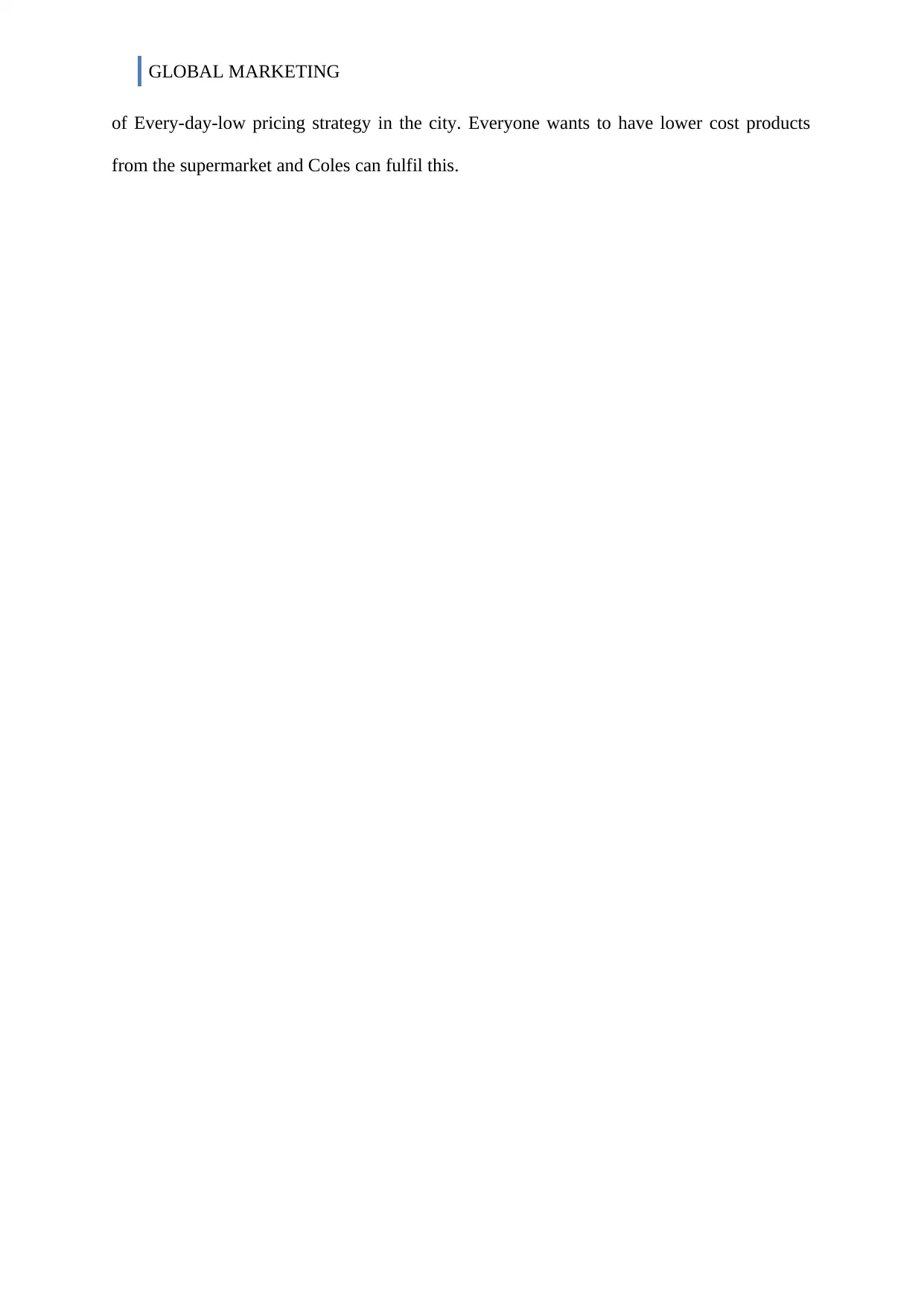
GLOBAL MARKETING
of Every-day-low pricing strategy in the city. Everyone wants to have lower cost products
from the supermarket and Coles can fulfil this.
of Every-day-low pricing strategy in the city. Everyone wants to have lower cost products
from the supermarket and Coles can fulfil this.
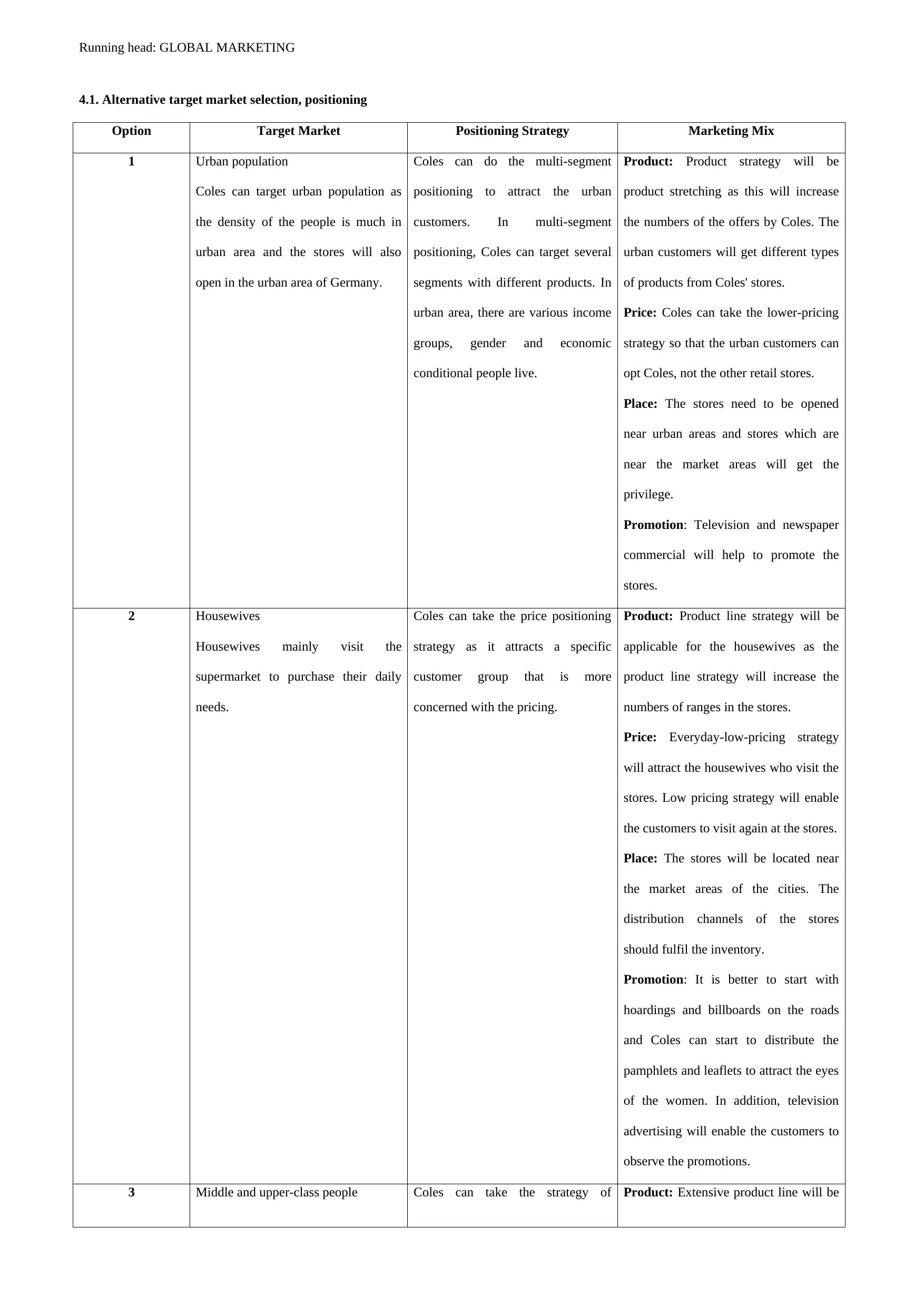
Running head: GLOBAL MARKETING
4.1. Alternative target market selection, positioning
Option Target Market Positioning Strategy Marketing Mix
1 Urban population
Coles can target urban population as
the density of the people is much in
urban area and the stores will also
open in the urban area of Germany.
Coles can do the multi-segment
positioning to attract the urban
customers. In multi-segment
positioning, Coles can target several
segments with different products. In
urban area, there are various income
groups, gender and economic
conditional people live.
Product: Product strategy will be
product stretching as this will increase
the numbers of the offers by Coles. The
urban customers will get different types
of products from Coles' stores.
Price: Coles can take the lower-pricing
strategy so that the urban customers can
opt Coles, not the other retail stores.
Place: The stores need to be opened
near urban areas and stores which are
near the market areas will get the
privilege.
Promotion: Television and newspaper
commercial will help to promote the
stores.
2 Housewives
Housewives mainly visit the
supermarket to purchase their daily
needs.
Coles can take the price positioning
strategy as it attracts a specific
customer group that is more
concerned with the pricing.
Product: Product line strategy will be
applicable for the housewives as the
product line strategy will increase the
numbers of ranges in the stores.
Price: Everyday-low-pricing strategy
will attract the housewives who visit the
stores. Low pricing strategy will enable
the customers to visit again at the stores.
Place: The stores will be located near
the market areas of the cities. The
distribution channels of the stores
should fulfil the inventory.
Promotion: It is better to start with
hoardings and billboards on the roads
and Coles can start to distribute the
pamphlets and leaflets to attract the eyes
of the women. In addition, television
advertising will enable the customers to
observe the promotions.
3 Middle and upper-class people Coles can take the strategy of Product: Extensive product line will be
4.1. Alternative target market selection, positioning
Option Target Market Positioning Strategy Marketing Mix
1 Urban population
Coles can target urban population as
the density of the people is much in
urban area and the stores will also
open in the urban area of Germany.
Coles can do the multi-segment
positioning to attract the urban
customers. In multi-segment
positioning, Coles can target several
segments with different products. In
urban area, there are various income
groups, gender and economic
conditional people live.
Product: Product strategy will be
product stretching as this will increase
the numbers of the offers by Coles. The
urban customers will get different types
of products from Coles' stores.
Price: Coles can take the lower-pricing
strategy so that the urban customers can
opt Coles, not the other retail stores.
Place: The stores need to be opened
near urban areas and stores which are
near the market areas will get the
privilege.
Promotion: Television and newspaper
commercial will help to promote the
stores.
2 Housewives
Housewives mainly visit the
supermarket to purchase their daily
needs.
Coles can take the price positioning
strategy as it attracts a specific
customer group that is more
concerned with the pricing.
Product: Product line strategy will be
applicable for the housewives as the
product line strategy will increase the
numbers of ranges in the stores.
Price: Everyday-low-pricing strategy
will attract the housewives who visit the
stores. Low pricing strategy will enable
the customers to visit again at the stores.
Place: The stores will be located near
the market areas of the cities. The
distribution channels of the stores
should fulfil the inventory.
Promotion: It is better to start with
hoardings and billboards on the roads
and Coles can start to distribute the
pamphlets and leaflets to attract the eyes
of the women. In addition, television
advertising will enable the customers to
observe the promotions.
3 Middle and upper-class people Coles can take the strategy of Product: Extensive product line will be
Paraphrase This Document
Need a fresh take? Get an instant paraphrase of this document with our AI Paraphraser
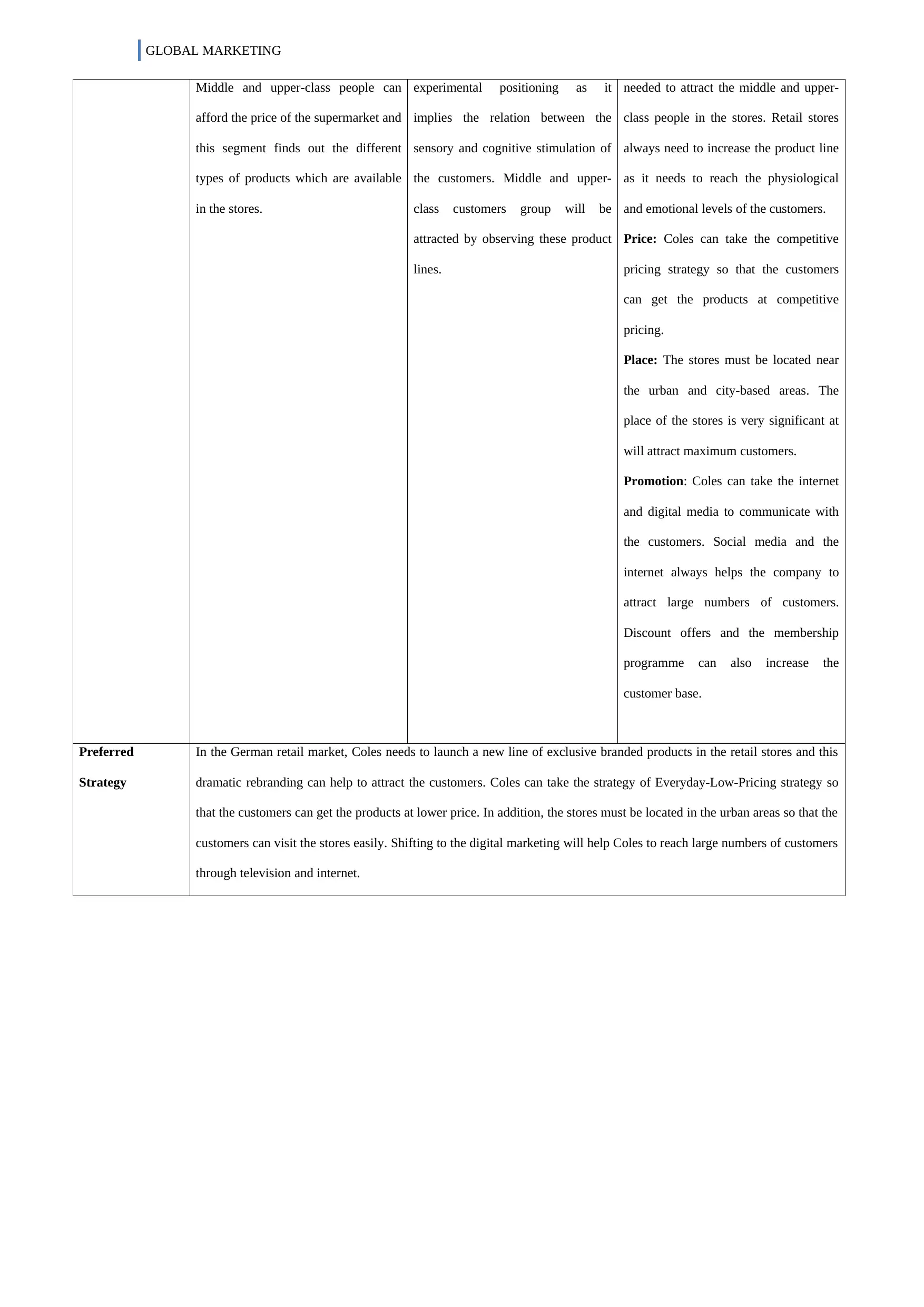
GLOBAL MARKETING
Middle and upper-class people can
afford the price of the supermarket and
this segment finds out the different
types of products which are available
in the stores.
experimental positioning as it
implies the relation between the
sensory and cognitive stimulation of
the customers. Middle and upper-
class customers group will be
attracted by observing these product
lines.
needed to attract the middle and upper-
class people in the stores. Retail stores
always need to increase the product line
as it needs to reach the physiological
and emotional levels of the customers.
Price: Coles can take the competitive
pricing strategy so that the customers
can get the products at competitive
pricing.
Place: The stores must be located near
the urban and city-based areas. The
place of the stores is very significant at
will attract maximum customers.
Promotion: Coles can take the internet
and digital media to communicate with
the customers. Social media and the
internet always helps the company to
attract large numbers of customers.
Discount offers and the membership
programme can also increase the
customer base.
Preferred
Strategy
In the German retail market, Coles needs to launch a new line of exclusive branded products in the retail stores and this
dramatic rebranding can help to attract the customers. Coles can take the strategy of Everyday-Low-Pricing strategy so
that the customers can get the products at lower price. In addition, the stores must be located in the urban areas so that the
customers can visit the stores easily. Shifting to the digital marketing will help Coles to reach large numbers of customers
through television and internet.
Middle and upper-class people can
afford the price of the supermarket and
this segment finds out the different
types of products which are available
in the stores.
experimental positioning as it
implies the relation between the
sensory and cognitive stimulation of
the customers. Middle and upper-
class customers group will be
attracted by observing these product
lines.
needed to attract the middle and upper-
class people in the stores. Retail stores
always need to increase the product line
as it needs to reach the physiological
and emotional levels of the customers.
Price: Coles can take the competitive
pricing strategy so that the customers
can get the products at competitive
pricing.
Place: The stores must be located near
the urban and city-based areas. The
place of the stores is very significant at
will attract maximum customers.
Promotion: Coles can take the internet
and digital media to communicate with
the customers. Social media and the
internet always helps the company to
attract large numbers of customers.
Discount offers and the membership
programme can also increase the
customer base.
Preferred
Strategy
In the German retail market, Coles needs to launch a new line of exclusive branded products in the retail stores and this
dramatic rebranding can help to attract the customers. Coles can take the strategy of Everyday-Low-Pricing strategy so
that the customers can get the products at lower price. In addition, the stores must be located in the urban areas so that the
customers can visit the stores easily. Shifting to the digital marketing will help Coles to reach large numbers of customers
through television and internet.

Running head: GLOBAL MARKETING
4.2. Market selection process
4.2.1. Target market selection process through alternative entry modes to the country of
choice
Franchising mode of entry will help to expand the business in no time to different
parts of Germany and it will help to attract the urban people. The franchising stores generally
open at urban sections. Franchising will help to target the urban people as the retail stores
will open near the urban areas.
Direct exporting can target the customers who belong to the middle and upper class of
the society. Direct exporting does not include other management or other organisations in the
process of entering; all the requirements are done by the company itself. Therefore, direct
exporting is associated with the middle and upper class of the society.
Joint venture leads to make the partnership with other company. In addition, the
partnership leads to offer various types of products and it will help to attract the housewives
and professional women to the stores.
4.3. Outline possible positioning for each of target markets in entry mode
In order to target the urban population, Coles can do the multi-segment positioning to
attract the urban customers.
To target the housewives and professional women, Coles can take the price
positioning strategy.
In order to target the middle and upper-class people, Coles can take the strategy of
experimental positioning.
4.2. Market selection process
4.2.1. Target market selection process through alternative entry modes to the country of
choice
Franchising mode of entry will help to expand the business in no time to different
parts of Germany and it will help to attract the urban people. The franchising stores generally
open at urban sections. Franchising will help to target the urban people as the retail stores
will open near the urban areas.
Direct exporting can target the customers who belong to the middle and upper class of
the society. Direct exporting does not include other management or other organisations in the
process of entering; all the requirements are done by the company itself. Therefore, direct
exporting is associated with the middle and upper class of the society.
Joint venture leads to make the partnership with other company. In addition, the
partnership leads to offer various types of products and it will help to attract the housewives
and professional women to the stores.
4.3. Outline possible positioning for each of target markets in entry mode
In order to target the urban population, Coles can do the multi-segment positioning to
attract the urban customers.
To target the housewives and professional women, Coles can take the price
positioning strategy.
In order to target the middle and upper-class people, Coles can take the strategy of
experimental positioning.
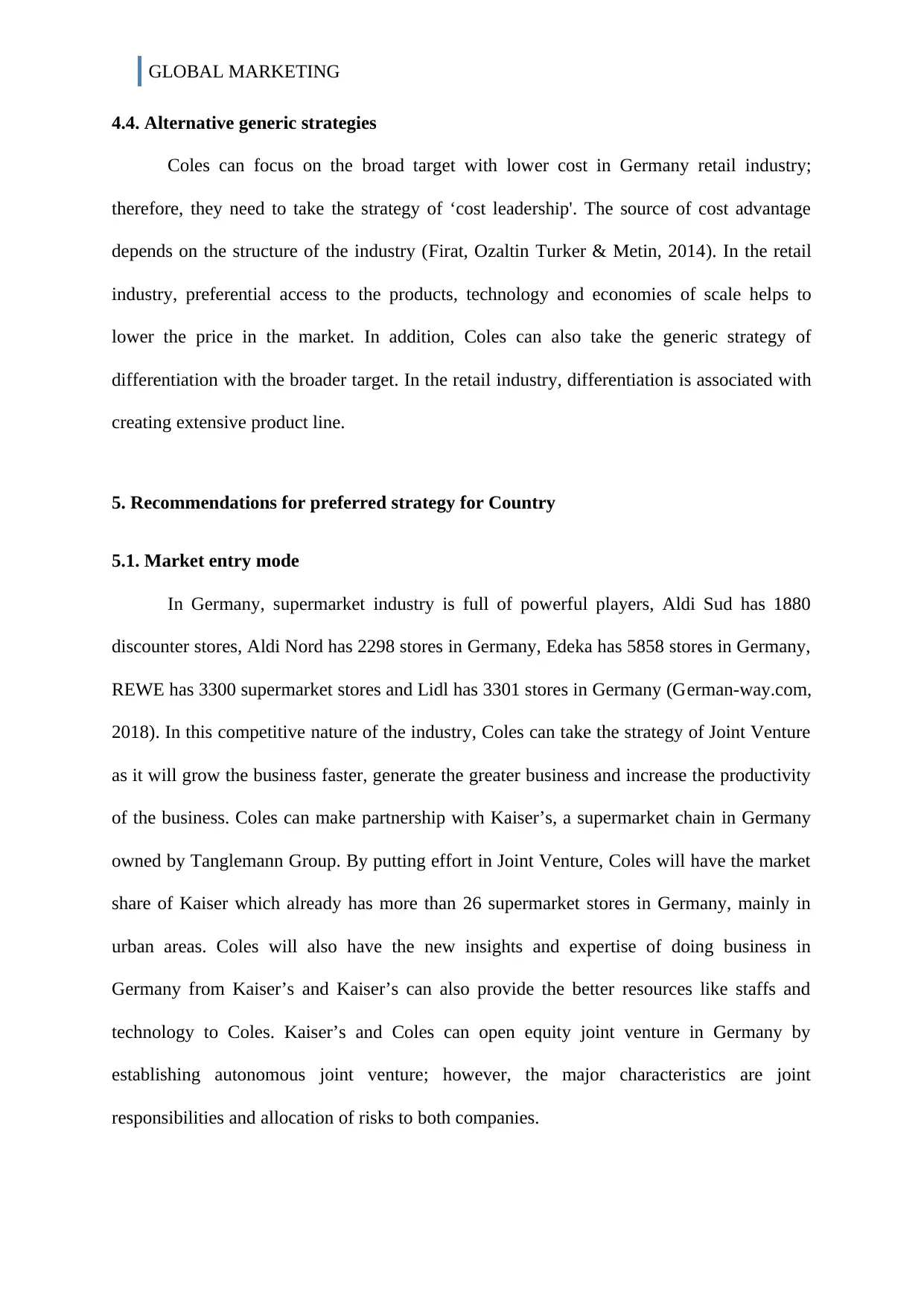
GLOBAL MARKETING
4.4. Alternative generic strategies
Coles can focus on the broad target with lower cost in Germany retail industry;
therefore, they need to take the strategy of ‘cost leadership'. The source of cost advantage
depends on the structure of the industry (Firat, Ozaltin Turker & Metin, 2014). In the retail
industry, preferential access to the products, technology and economies of scale helps to
lower the price in the market. In addition, Coles can also take the generic strategy of
differentiation with the broader target. In the retail industry, differentiation is associated with
creating extensive product line.
5. Recommendations for preferred strategy for Country
5.1. Market entry mode
In Germany, supermarket industry is full of powerful players, Aldi Sud has 1880
discounter stores, Aldi Nord has 2298 stores in Germany, Edeka has 5858 stores in Germany,
REWE has 3300 supermarket stores and Lidl has 3301 stores in Germany (German-way.com,
2018). In this competitive nature of the industry, Coles can take the strategy of Joint Venture
as it will grow the business faster, generate the greater business and increase the productivity
of the business. Coles can make partnership with Kaiser’s, a supermarket chain in Germany
owned by Tanglemann Group. By putting effort in Joint Venture, Coles will have the market
share of Kaiser which already has more than 26 supermarket stores in Germany, mainly in
urban areas. Coles will also have the new insights and expertise of doing business in
Germany from Kaiser’s and Kaiser’s can also provide the better resources like staffs and
technology to Coles. Kaiser’s and Coles can open equity joint venture in Germany by
establishing autonomous joint venture; however, the major characteristics are joint
responsibilities and allocation of risks to both companies.
4.4. Alternative generic strategies
Coles can focus on the broad target with lower cost in Germany retail industry;
therefore, they need to take the strategy of ‘cost leadership'. The source of cost advantage
depends on the structure of the industry (Firat, Ozaltin Turker & Metin, 2014). In the retail
industry, preferential access to the products, technology and economies of scale helps to
lower the price in the market. In addition, Coles can also take the generic strategy of
differentiation with the broader target. In the retail industry, differentiation is associated with
creating extensive product line.
5. Recommendations for preferred strategy for Country
5.1. Market entry mode
In Germany, supermarket industry is full of powerful players, Aldi Sud has 1880
discounter stores, Aldi Nord has 2298 stores in Germany, Edeka has 5858 stores in Germany,
REWE has 3300 supermarket stores and Lidl has 3301 stores in Germany (German-way.com,
2018). In this competitive nature of the industry, Coles can take the strategy of Joint Venture
as it will grow the business faster, generate the greater business and increase the productivity
of the business. Coles can make partnership with Kaiser’s, a supermarket chain in Germany
owned by Tanglemann Group. By putting effort in Joint Venture, Coles will have the market
share of Kaiser which already has more than 26 supermarket stores in Germany, mainly in
urban areas. Coles will also have the new insights and expertise of doing business in
Germany from Kaiser’s and Kaiser’s can also provide the better resources like staffs and
technology to Coles. Kaiser’s and Coles can open equity joint venture in Germany by
establishing autonomous joint venture; however, the major characteristics are joint
responsibilities and allocation of risks to both companies.
Secure Best Marks with AI Grader
Need help grading? Try our AI Grader for instant feedback on your assignments.
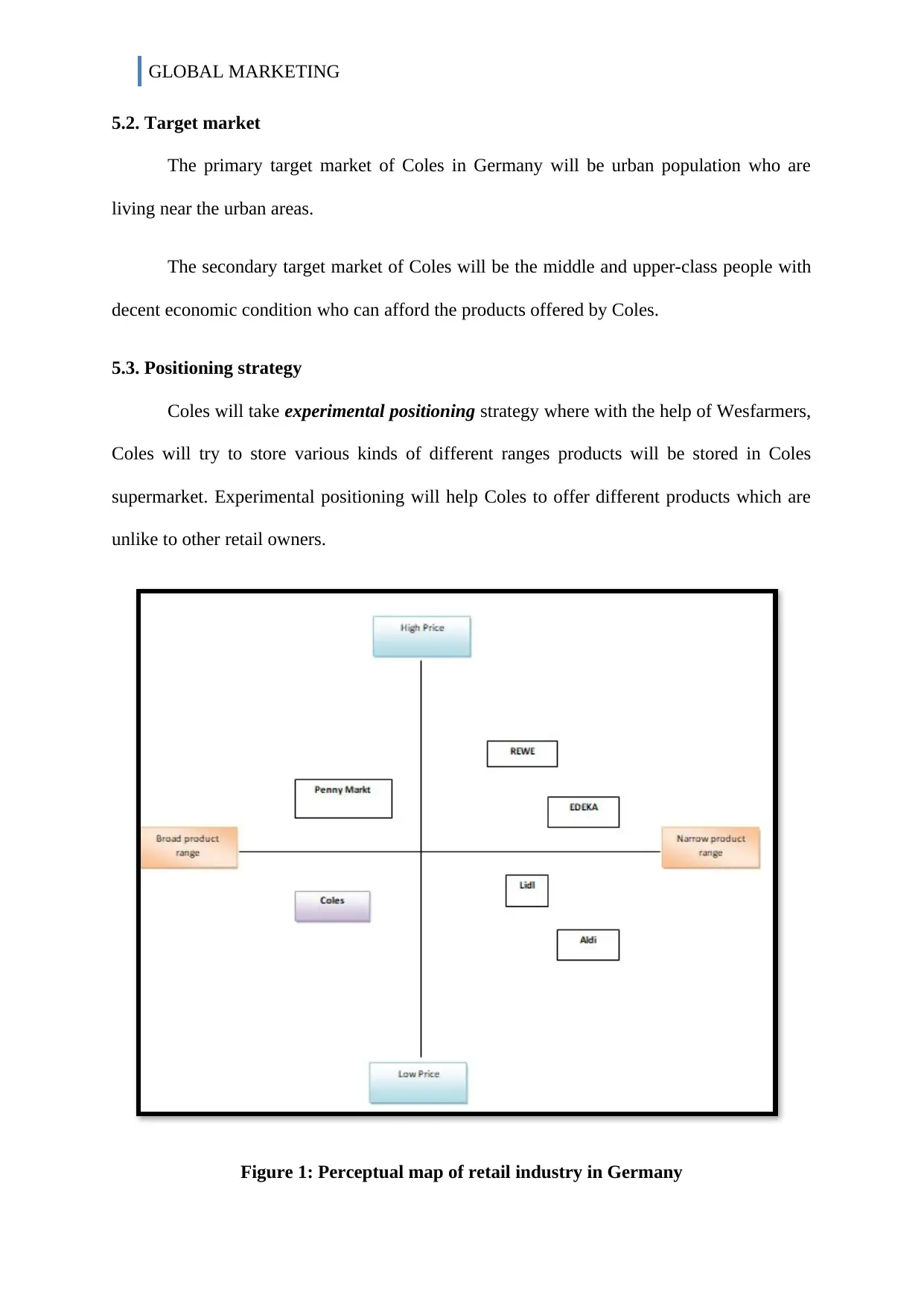
GLOBAL MARKETING
5.2. Target market
The primary target market of Coles in Germany will be urban population who are
living near the urban areas.
The secondary target market of Coles will be the middle and upper-class people with
decent economic condition who can afford the products offered by Coles.
5.3. Positioning strategy
Coles will take experimental positioning strategy where with the help of Wesfarmers,
Coles will try to store various kinds of different ranges products will be stored in Coles
supermarket. Experimental positioning will help Coles to offer different products which are
unlike to other retail owners.
Figure 1: Perceptual map of retail industry in Germany
5.2. Target market
The primary target market of Coles in Germany will be urban population who are
living near the urban areas.
The secondary target market of Coles will be the middle and upper-class people with
decent economic condition who can afford the products offered by Coles.
5.3. Positioning strategy
Coles will take experimental positioning strategy where with the help of Wesfarmers,
Coles will try to store various kinds of different ranges products will be stored in Coles
supermarket. Experimental positioning will help Coles to offer different products which are
unlike to other retail owners.
Figure 1: Perceptual map of retail industry in Germany
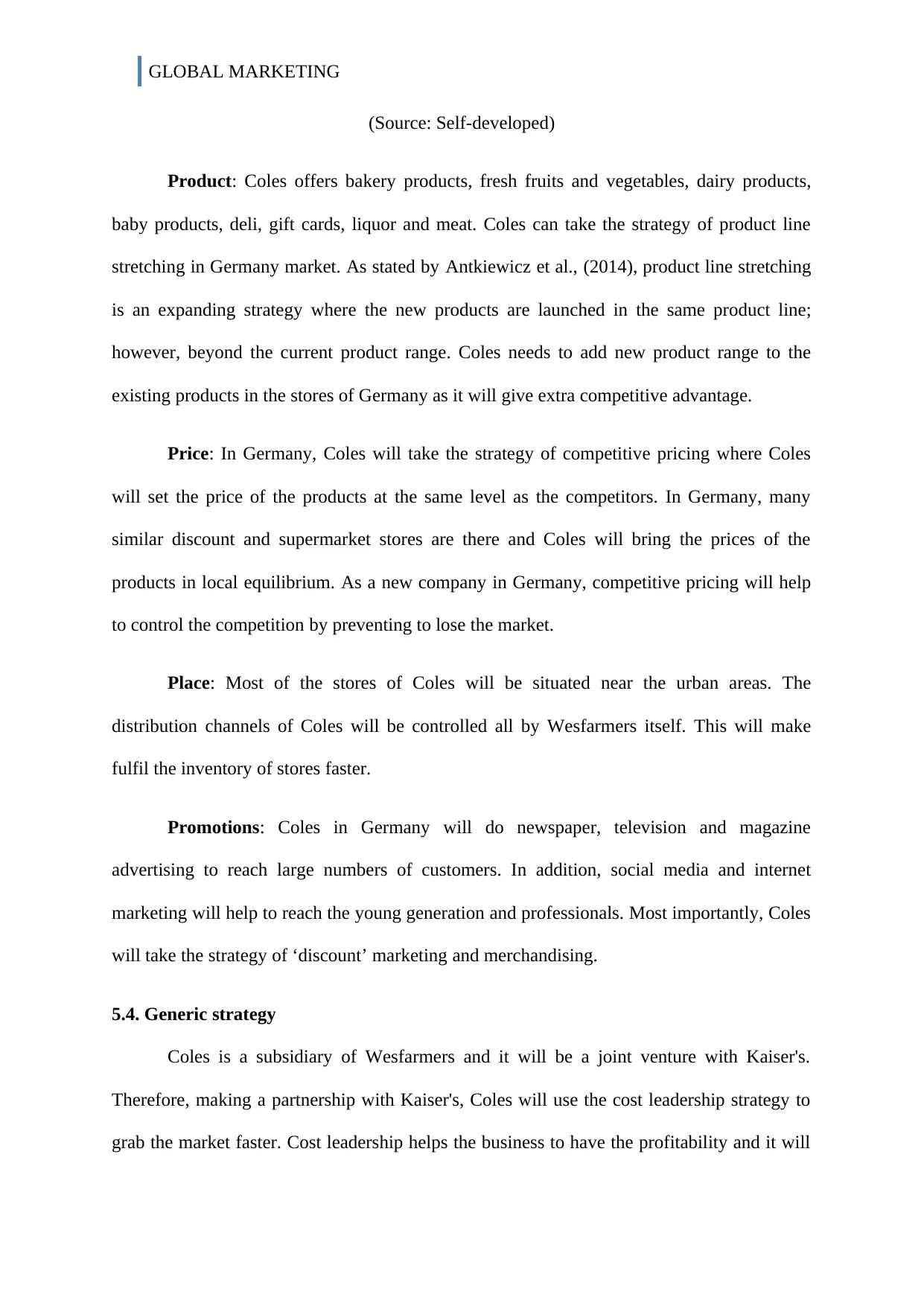
GLOBAL MARKETING
(Source: Self-developed)
Product: Coles offers bakery products, fresh fruits and vegetables, dairy products,
baby products, deli, gift cards, liquor and meat. Coles can take the strategy of product line
stretching in Germany market. As stated by Antkiewicz et al., (2014), product line stretching
is an expanding strategy where the new products are launched in the same product line;
however, beyond the current product range. Coles needs to add new product range to the
existing products in the stores of Germany as it will give extra competitive advantage.
Price: In Germany, Coles will take the strategy of competitive pricing where Coles
will set the price of the products at the same level as the competitors. In Germany, many
similar discount and supermarket stores are there and Coles will bring the prices of the
products in local equilibrium. As a new company in Germany, competitive pricing will help
to control the competition by preventing to lose the market.
Place: Most of the stores of Coles will be situated near the urban areas. The
distribution channels of Coles will be controlled all by Wesfarmers itself. This will make
fulfil the inventory of stores faster.
Promotions: Coles in Germany will do newspaper, television and magazine
advertising to reach large numbers of customers. In addition, social media and internet
marketing will help to reach the young generation and professionals. Most importantly, Coles
will take the strategy of ‘discount’ marketing and merchandising.
5.4. Generic strategy
Coles is a subsidiary of Wesfarmers and it will be a joint venture with Kaiser's.
Therefore, making a partnership with Kaiser's, Coles will use the cost leadership strategy to
grab the market faster. Cost leadership helps the business to have the profitability and it will
(Source: Self-developed)
Product: Coles offers bakery products, fresh fruits and vegetables, dairy products,
baby products, deli, gift cards, liquor and meat. Coles can take the strategy of product line
stretching in Germany market. As stated by Antkiewicz et al., (2014), product line stretching
is an expanding strategy where the new products are launched in the same product line;
however, beyond the current product range. Coles needs to add new product range to the
existing products in the stores of Germany as it will give extra competitive advantage.
Price: In Germany, Coles will take the strategy of competitive pricing where Coles
will set the price of the products at the same level as the competitors. In Germany, many
similar discount and supermarket stores are there and Coles will bring the prices of the
products in local equilibrium. As a new company in Germany, competitive pricing will help
to control the competition by preventing to lose the market.
Place: Most of the stores of Coles will be situated near the urban areas. The
distribution channels of Coles will be controlled all by Wesfarmers itself. This will make
fulfil the inventory of stores faster.
Promotions: Coles in Germany will do newspaper, television and magazine
advertising to reach large numbers of customers. In addition, social media and internet
marketing will help to reach the young generation and professionals. Most importantly, Coles
will take the strategy of ‘discount’ marketing and merchandising.
5.4. Generic strategy
Coles is a subsidiary of Wesfarmers and it will be a joint venture with Kaiser's.
Therefore, making a partnership with Kaiser's, Coles will use the cost leadership strategy to
grab the market faster. Cost leadership helps the business to have the profitability and it will
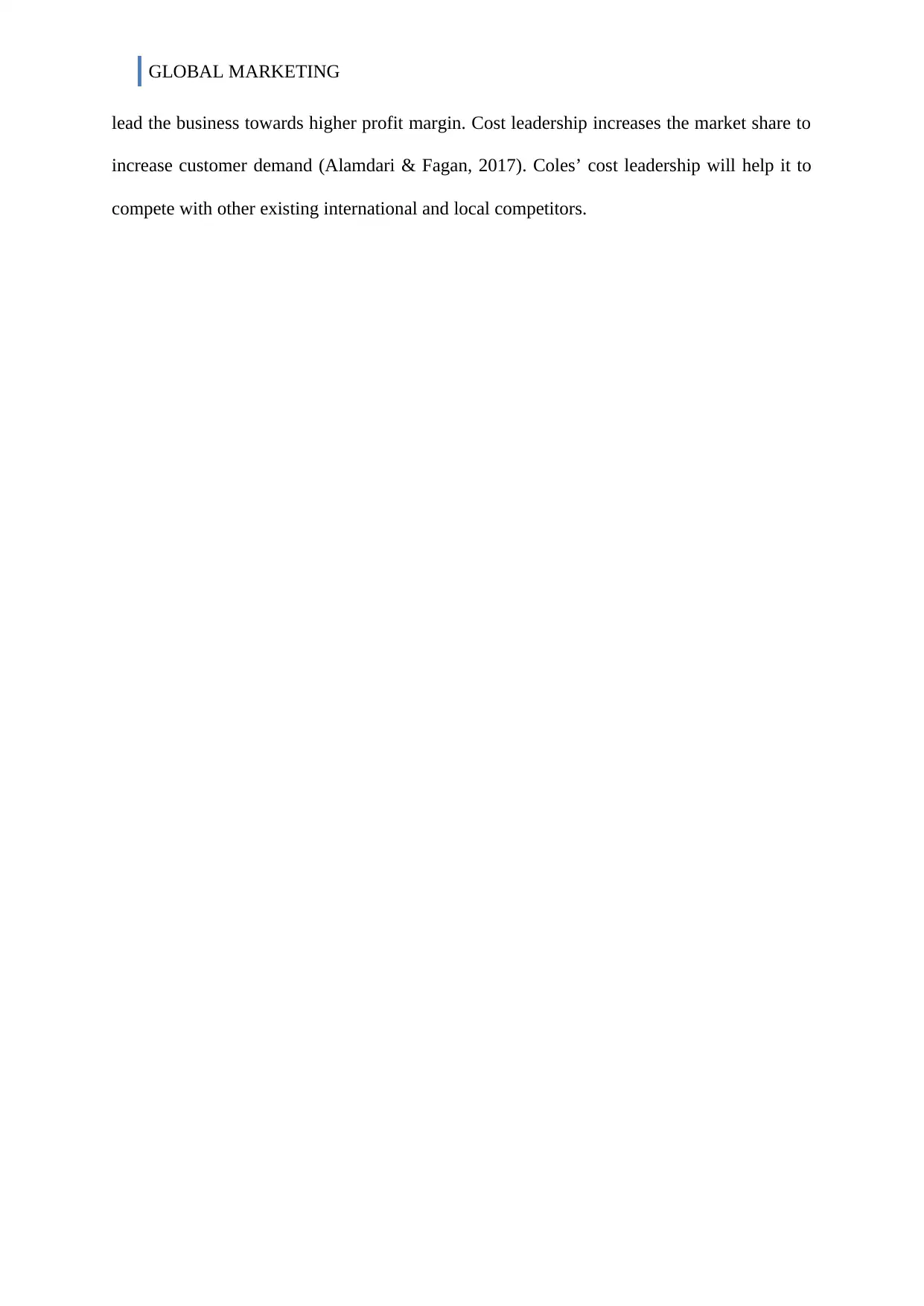
GLOBAL MARKETING
lead the business towards higher profit margin. Cost leadership increases the market share to
increase customer demand (Alamdari & Fagan, 2017). Coles’ cost leadership will help it to
compete with other existing international and local competitors.
lead the business towards higher profit margin. Cost leadership increases the market share to
increase customer demand (Alamdari & Fagan, 2017). Coles’ cost leadership will help it to
compete with other existing international and local competitors.
Paraphrase This Document
Need a fresh take? Get an instant paraphrase of this document with our AI Paraphraser
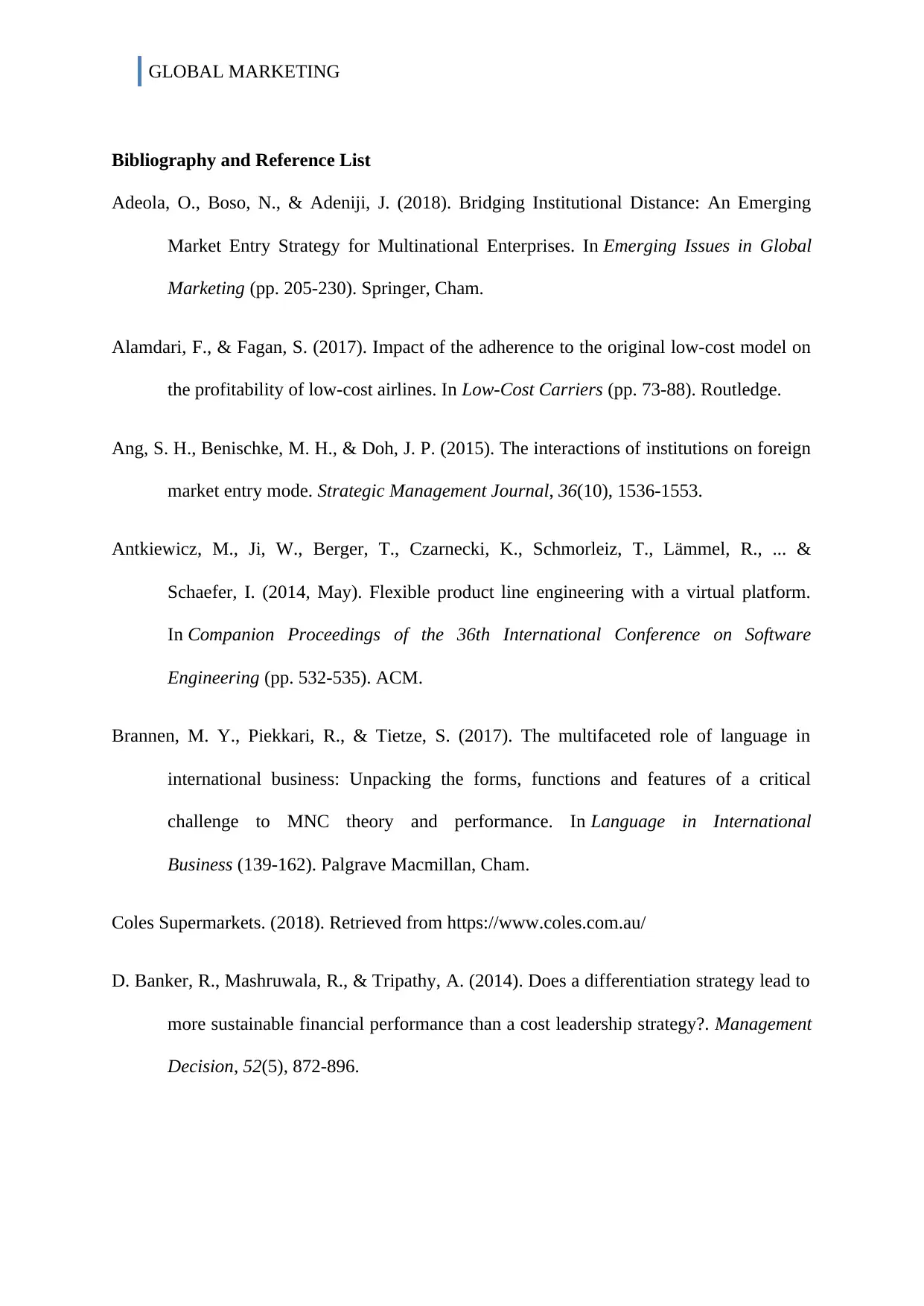
GLOBAL MARKETING
Bibliography and Reference List
Adeola, O., Boso, N., & Adeniji, J. (2018). Bridging Institutional Distance: An Emerging
Market Entry Strategy for Multinational Enterprises. In Emerging Issues in Global
Marketing (pp. 205-230). Springer, Cham.
Alamdari, F., & Fagan, S. (2017). Impact of the adherence to the original low-cost model on
the profitability of low-cost airlines. In Low-Cost Carriers (pp. 73-88). Routledge.
Ang, S. H., Benischke, M. H., & Doh, J. P. (2015). The interactions of institutions on foreign
market entry mode. Strategic Management Journal, 36(10), 1536-1553.
Antkiewicz, M., Ji, W., Berger, T., Czarnecki, K., Schmorleiz, T., Lämmel, R., ... &
Schaefer, I. (2014, May). Flexible product line engineering with a virtual platform.
In Companion Proceedings of the 36th International Conference on Software
Engineering (pp. 532-535). ACM.
Brannen, M. Y., Piekkari, R., & Tietze, S. (2017). The multifaceted role of language in
international business: Unpacking the forms, functions and features of a critical
challenge to MNC theory and performance. In Language in International
Business (139-162). Palgrave Macmillan, Cham.
Coles Supermarkets. (2018). Retrieved from https://www.coles.com.au/
D. Banker, R., Mashruwala, R., & Tripathy, A. (2014). Does a differentiation strategy lead to
more sustainable financial performance than a cost leadership strategy?. Management
Decision, 52(5), 872-896.
Bibliography and Reference List
Adeola, O., Boso, N., & Adeniji, J. (2018). Bridging Institutional Distance: An Emerging
Market Entry Strategy for Multinational Enterprises. In Emerging Issues in Global
Marketing (pp. 205-230). Springer, Cham.
Alamdari, F., & Fagan, S. (2017). Impact of the adherence to the original low-cost model on
the profitability of low-cost airlines. In Low-Cost Carriers (pp. 73-88). Routledge.
Ang, S. H., Benischke, M. H., & Doh, J. P. (2015). The interactions of institutions on foreign
market entry mode. Strategic Management Journal, 36(10), 1536-1553.
Antkiewicz, M., Ji, W., Berger, T., Czarnecki, K., Schmorleiz, T., Lämmel, R., ... &
Schaefer, I. (2014, May). Flexible product line engineering with a virtual platform.
In Companion Proceedings of the 36th International Conference on Software
Engineering (pp. 532-535). ACM.
Brannen, M. Y., Piekkari, R., & Tietze, S. (2017). The multifaceted role of language in
international business: Unpacking the forms, functions and features of a critical
challenge to MNC theory and performance. In Language in International
Business (139-162). Palgrave Macmillan, Cham.
Coles Supermarkets. (2018). Retrieved from https://www.coles.com.au/
D. Banker, R., Mashruwala, R., & Tripathy, A. (2014). Does a differentiation strategy lead to
more sustainable financial performance than a cost leadership strategy?. Management
Decision, 52(5), 872-896.
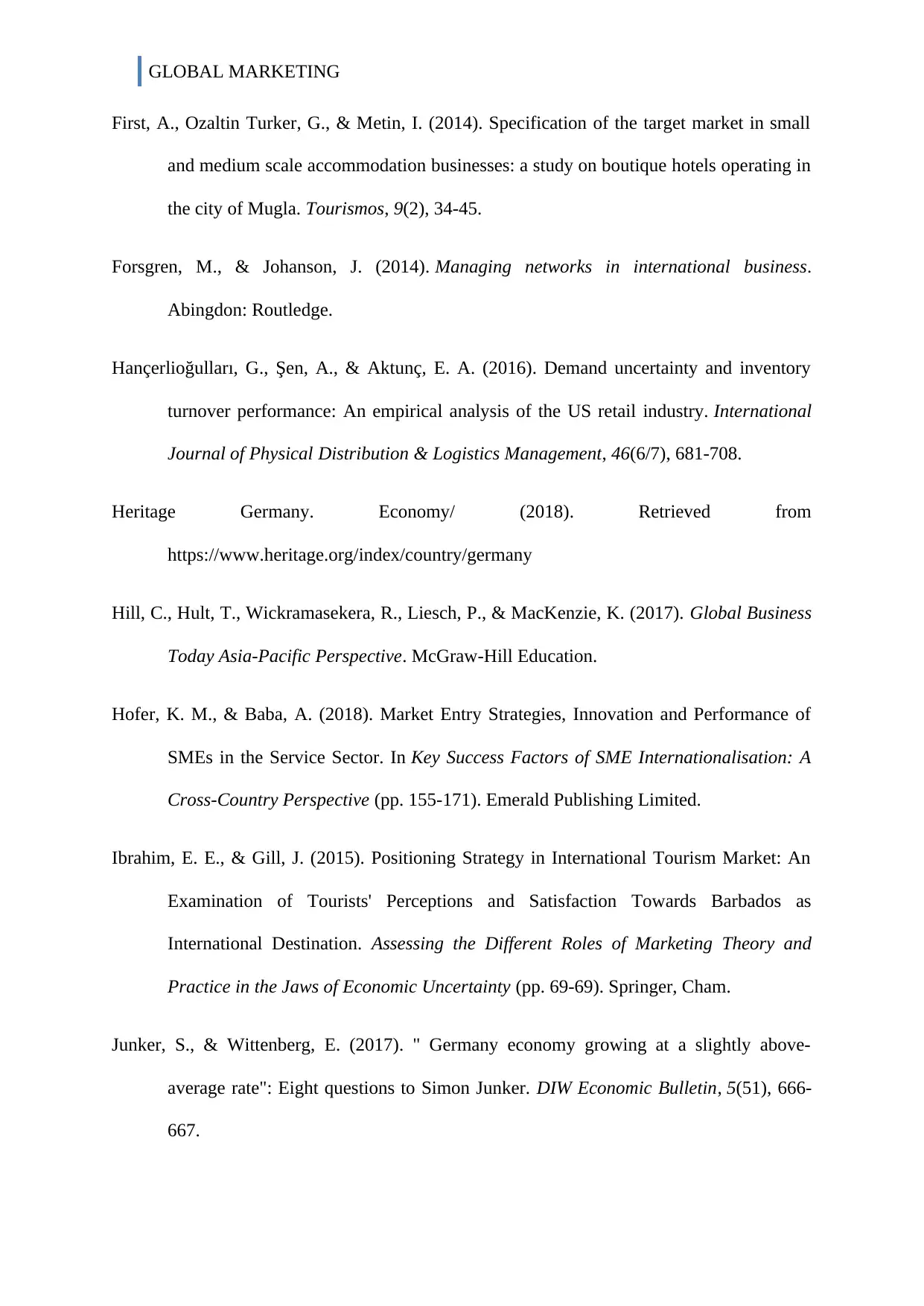
GLOBAL MARKETING
First, A., Ozaltin Turker, G., & Metin, I. (2014). Specification of the target market in small
and medium scale accommodation businesses: a study on boutique hotels operating in
the city of Mugla. Tourismos, 9(2), 34-45.
Forsgren, M., & Johanson, J. (2014). Managing networks in international business.
Abingdon: Routledge.
Hançerlioğulları, G., Şen, A., & Aktunç, E. A. (2016). Demand uncertainty and inventory
turnover performance: An empirical analysis of the US retail industry. International
Journal of Physical Distribution & Logistics Management, 46(6/7), 681-708.
Heritage Germany. Economy/ (2018). Retrieved from
https://www.heritage.org/index/country/germany
Hill, C., Hult, T., Wickramasekera, R., Liesch, P., & MacKenzie, K. (2017). Global Business
Today Asia-Pacific Perspective. McGraw-Hill Education.
Hofer, K. M., & Baba, A. (2018). Market Entry Strategies, Innovation and Performance of
SMEs in the Service Sector. In Key Success Factors of SME Internationalisation: A
Cross-Country Perspective (pp. 155-171). Emerald Publishing Limited.
Ibrahim, E. E., & Gill, J. (2015). Positioning Strategy in International Tourism Market: An
Examination of Tourists' Perceptions and Satisfaction Towards Barbados as
International Destination. Assessing the Different Roles of Marketing Theory and
Practice in the Jaws of Economic Uncertainty (pp. 69-69). Springer, Cham.
Junker, S., & Wittenberg, E. (2017). " Germany economy growing at a slightly above-
average rate": Eight questions to Simon Junker. DIW Economic Bulletin, 5(51), 666-
667.
First, A., Ozaltin Turker, G., & Metin, I. (2014). Specification of the target market in small
and medium scale accommodation businesses: a study on boutique hotels operating in
the city of Mugla. Tourismos, 9(2), 34-45.
Forsgren, M., & Johanson, J. (2014). Managing networks in international business.
Abingdon: Routledge.
Hançerlioğulları, G., Şen, A., & Aktunç, E. A. (2016). Demand uncertainty and inventory
turnover performance: An empirical analysis of the US retail industry. International
Journal of Physical Distribution & Logistics Management, 46(6/7), 681-708.
Heritage Germany. Economy/ (2018). Retrieved from
https://www.heritage.org/index/country/germany
Hill, C., Hult, T., Wickramasekera, R., Liesch, P., & MacKenzie, K. (2017). Global Business
Today Asia-Pacific Perspective. McGraw-Hill Education.
Hofer, K. M., & Baba, A. (2018). Market Entry Strategies, Innovation and Performance of
SMEs in the Service Sector. In Key Success Factors of SME Internationalisation: A
Cross-Country Perspective (pp. 155-171). Emerald Publishing Limited.
Ibrahim, E. E., & Gill, J. (2015). Positioning Strategy in International Tourism Market: An
Examination of Tourists' Perceptions and Satisfaction Towards Barbados as
International Destination. Assessing the Different Roles of Marketing Theory and
Practice in the Jaws of Economic Uncertainty (pp. 69-69). Springer, Cham.
Junker, S., & Wittenberg, E. (2017). " Germany economy growing at a slightly above-
average rate": Eight questions to Simon Junker. DIW Economic Bulletin, 5(51), 666-
667.
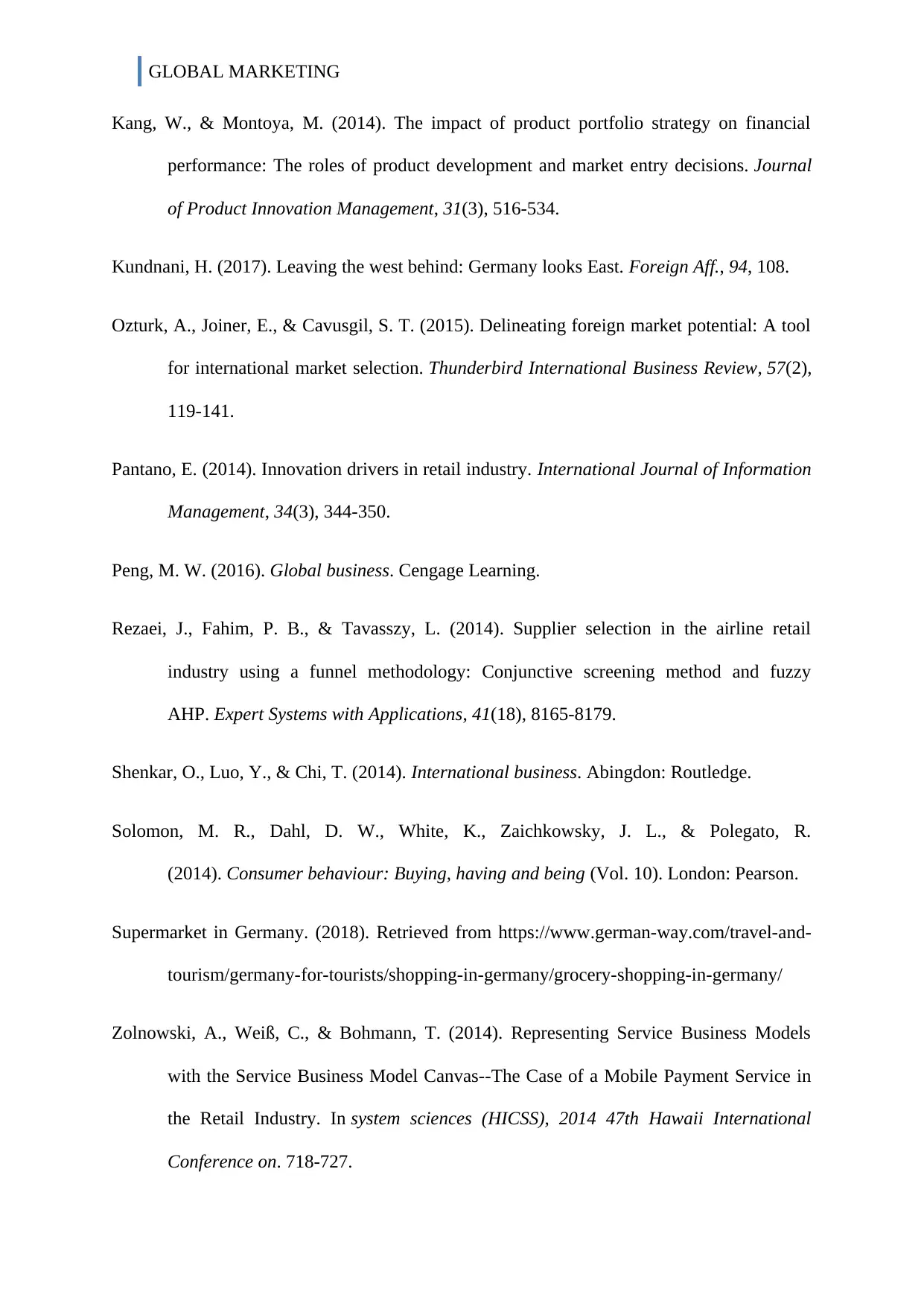
GLOBAL MARKETING
Kang, W., & Montoya, M. (2014). The impact of product portfolio strategy on financial
performance: The roles of product development and market entry decisions. Journal
of Product Innovation Management, 31(3), 516-534.
Kundnani, H. (2017). Leaving the west behind: Germany looks East. Foreign Aff., 94, 108.
Ozturk, A., Joiner, E., & Cavusgil, S. T. (2015). Delineating foreign market potential: A tool
for international market selection. Thunderbird International Business Review, 57(2),
119-141.
Pantano, E. (2014). Innovation drivers in retail industry. International Journal of Information
Management, 34(3), 344-350.
Peng, M. W. (2016). Global business. Cengage Learning.
Rezaei, J., Fahim, P. B., & Tavasszy, L. (2014). Supplier selection in the airline retail
industry using a funnel methodology: Conjunctive screening method and fuzzy
AHP. Expert Systems with Applications, 41(18), 8165-8179.
Shenkar, O., Luo, Y., & Chi, T. (2014). International business. Abingdon: Routledge.
Solomon, M. R., Dahl, D. W., White, K., Zaichkowsky, J. L., & Polegato, R.
(2014). Consumer behaviour: Buying, having and being (Vol. 10). London: Pearson.
Supermarket in Germany. (2018). Retrieved from https://www.german-way.com/travel-and-
tourism/germany-for-tourists/shopping-in-germany/grocery-shopping-in-germany/
Zolnowski, A., Weiß, C., & Bohmann, T. (2014). Representing Service Business Models
with the Service Business Model Canvas--The Case of a Mobile Payment Service in
the Retail Industry. In system sciences (HICSS), 2014 47th Hawaii International
Conference on. 718-727.
Kang, W., & Montoya, M. (2014). The impact of product portfolio strategy on financial
performance: The roles of product development and market entry decisions. Journal
of Product Innovation Management, 31(3), 516-534.
Kundnani, H. (2017). Leaving the west behind: Germany looks East. Foreign Aff., 94, 108.
Ozturk, A., Joiner, E., & Cavusgil, S. T. (2015). Delineating foreign market potential: A tool
for international market selection. Thunderbird International Business Review, 57(2),
119-141.
Pantano, E. (2014). Innovation drivers in retail industry. International Journal of Information
Management, 34(3), 344-350.
Peng, M. W. (2016). Global business. Cengage Learning.
Rezaei, J., Fahim, P. B., & Tavasszy, L. (2014). Supplier selection in the airline retail
industry using a funnel methodology: Conjunctive screening method and fuzzy
AHP. Expert Systems with Applications, 41(18), 8165-8179.
Shenkar, O., Luo, Y., & Chi, T. (2014). International business. Abingdon: Routledge.
Solomon, M. R., Dahl, D. W., White, K., Zaichkowsky, J. L., & Polegato, R.
(2014). Consumer behaviour: Buying, having and being (Vol. 10). London: Pearson.
Supermarket in Germany. (2018). Retrieved from https://www.german-way.com/travel-and-
tourism/germany-for-tourists/shopping-in-germany/grocery-shopping-in-germany/
Zolnowski, A., Weiß, C., & Bohmann, T. (2014). Representing Service Business Models
with the Service Business Model Canvas--The Case of a Mobile Payment Service in
the Retail Industry. In system sciences (HICSS), 2014 47th Hawaii International
Conference on. 718-727.
1 out of 22
Related Documents
Your All-in-One AI-Powered Toolkit for Academic Success.
+13062052269
info@desklib.com
Available 24*7 on WhatsApp / Email
![[object Object]](/_next/static/media/star-bottom.7253800d.svg)
Unlock your academic potential
© 2024 | Zucol Services PVT LTD | All rights reserved.





